#Fernando II de Aragon
Text
In Spain, ladies-in-waiting received a dowry from their royal mistress when they married. Princess Catherine, unable even to feed and clothe her household adequately, was consumed with anxiety over this. Ordinarily she could have expected marriages to occur between her women and the English nobility, for this was one way in which women acted as peace-weavers, strengthening alliances between countries. But her women were reliant on the goodwill of King Ferdinand, and on their own families.
The Princess was repeatedly and vocally concerned about the plight of her ladies-in-waiting. In 1505 she asked her father to pay María de Salazar, because she was unable to, and noted that six of her women had served her devotedly without any remuneration. In 1507 she again pleaded with Ferdinand for money for them, explaining that by now she had only five women in her service and that ‘they have never received the smallest sum of money since they were in England […] cannot think of them without pangs of conscience’.
Nicola Clark, THE WAITING GAME: THE UNTOLD STORY OF THE WOMEN WHO SERVED THE TUDOR QUEENS
#catherine of aragon#katherine of aragon#catalina de aragon#ferdinand ii of aragon#fernando ii de aragon
6 notes
·
View notes
Text
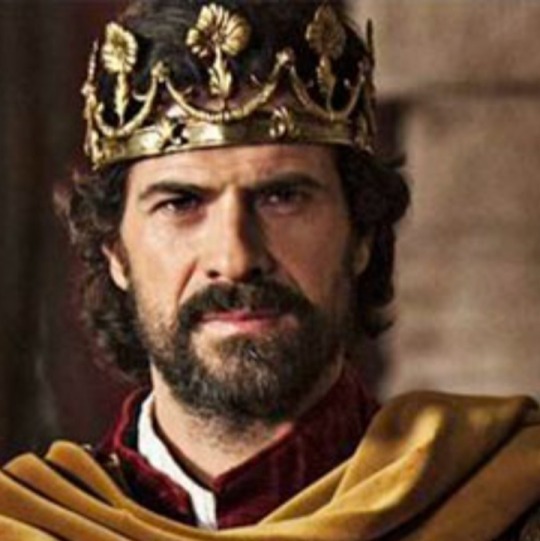




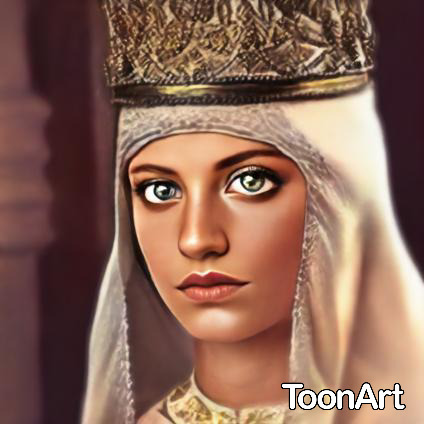



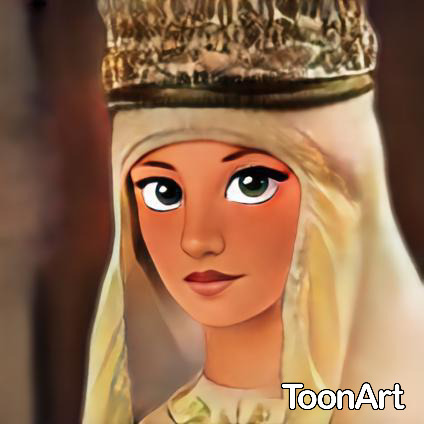
Michelle Jenner and Rodolfo Sancho as Isabel de Castilla and Fernando de Aragon in Isabel
#isabel tve#michelle jenner#rodolfo sancho#isabella i of castile#ferdinand ii of aragon#isabel de castilla#fernando II de aragon#tumblr art
8 notes
·
View notes
Text

Fernando de Aragón in prayers
#Ferdinand II of Aragon#Fernando II#Fernando II de Aragón#Fernando de Aragón#House of Trastamara#16th century
7 notes
·
View notes
Text

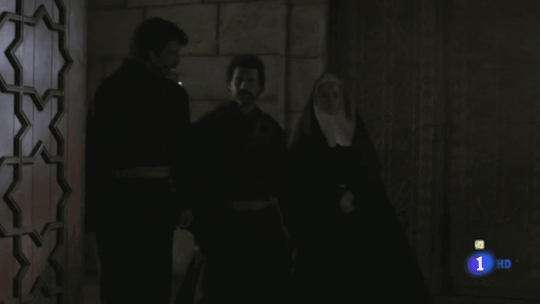


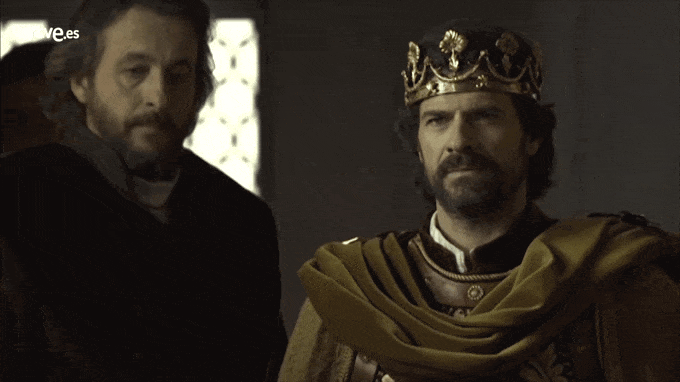
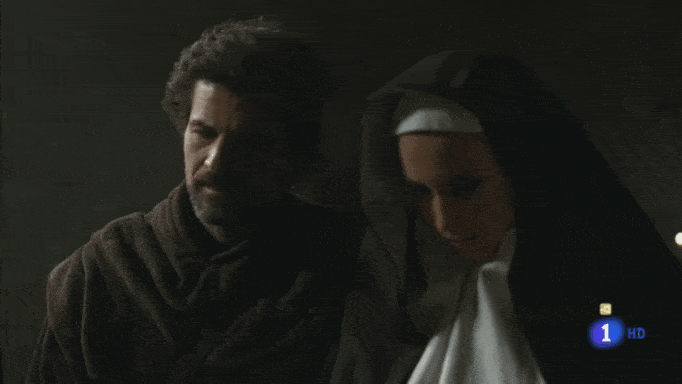

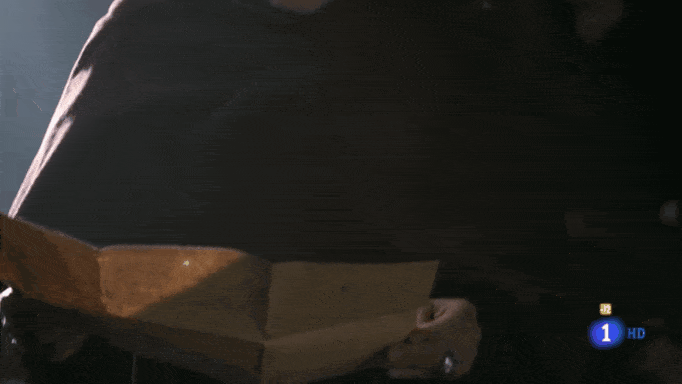


Juraría que la conozco de algo...
Isabel (2012-2014), 2×01 Desencuentros II El Ministerio del tiempo (2015-), 1×04 Una negociación a tiempo
#el ministerio del tiempo#isabel tve#1×04#una negociación a tiempo#2×01#desencuentros#nacho fresneda#aura garrido#rodolfo sancho#michelle jenner#eusebio poncela#ramón madaula#alonso de entrerríos#amelia folch#julián martínez#fernando ii de aragón#ferdinand ii of aragon#isabella i of castile#isabel i de castilla#cardenal cisneros#gonzalo chacón#francisco jiménez de cisneros#emdt#mdt
66 notes
·
View notes
Text
"In total, Leonor governed Navarre as lieutenant, with some minor hiatuses, from 1455 to 1479, making her the effective ruler of the realm for nearly twenty five years. Out of her female predecessors, only Juana I served a longer period; however, Juana I was detached from the governance of the realm and physically distant from Navarre. Leonor however, remained in the kingdom throughout her lieutenancy, making her the female sovereign with the highest record of residency in Navarre.
One of the enabling factors for Leonor’s constant presence in the realm was the “Divide and Conquer” power-sharing mechanism that she employed with her husband, Gaston of Foix. Blanca and Juan had a similar division of duties, but unlike her parents’ often contrary objectives, all of Leonor and Gaston’s actions can be seen to be working toward their joint goals of obtaining the Navarrese crown and politically dominating the Pyrenean region. In order to achieve their ambitions, the couple were adept at working as a team even when physically seperated or carrying out divergent duties.
Politically, it appears that they took on different areas of negotiatiion. Gaston was the designated emissary to the French court, which was entirely appropriate as one of the French king’s leading magnates. One important example of his involvement in negotiations of this type include Gaston’s visit to the French court in the winter of 1461–62 to negotiate the marriage between their heir and the French princess, Magdalena, which ensured Louis XI’s backing for Leonor’s promotion to primogenita. Gaston also conducted negotiations on behalf of his father-in-law, Juan of Aragon, with the King of France, with a successful outcome in the case of the Treaty of Olite in April 1462, which was intimately connected to the marriage that Gaston was orchestrating for his son and Magdalena of France.
Even though Gaston normally took on the role of intermediary with the French crown, there are two letters issued by Leonor during her marriage in December 1466 as lieutenant of Navarre that show her involvement in French affairs. These letters were written during a period of extreme crisis, when Juan II’s difficulties in Catalonia were matched with Leonor’s continuing struggle with the Peralta clan in Navarre. In these letters, Leonor was playing on her familial connection to Louis XI, in hopes of his aid and backing, asking him to “commend this poor kingdom and the said princess to him [Louis XI] as one who is of his house.” Moreover, these letters show Leonor’s independent interaction in crucial diplomatic negotiations with France, both in receiving embassies directly from Louis and in sending her own personal ambassador, Fernando de Baquedano, with detailed instructions on how to proceed.
Gaston appears to have been more engaged with marital negotiations for their numerous offspring than Leonor. However, this may be due to the fact that the couple overwhelmingly chose French marriages for their children. Only three of Leonor’s children did not contract a French betrothal: Pierre who became a cardinal, a daughter who died young, and Leonor’s youngest son, Jacques (or Jaime), who married into the Navarrese nobility. Given the fact that Gaston was more intimately connected to the French court and the nobility of the Midi, it seems reasonable that he would take on the role of chief negotiator for these matches. All of the marital arrangements for their children were made in order for Gaston and Leonor to achieve their joint goals, the acquisition of the throne of Navarre and the consolidation of their power and influence in the Pyrenean region.
Another area where Gaston necessarily played a more central role was militarily. Robin Harris acknowledges Gaston’s successful military career and notes that after his useful military service to the French crown, “the comte was permitted by the [French] king in the last years of his life to employ his military resources in order to further his family’s interests in Navarre.” Gaston also performed many military services for his father-in-law; the agreement of 1455 that promoted Leonor and Gaston to the successors of the realm required Gaston to go to Navarre on Juan’s behalf and retake those areas that had fallen to the rebels “for the honor of the King of Navarre as well as for his own interests and those of the princess his wife."
However, there is some evidence for Leonor’s involvement in one military foray. In the winter of 1471, Leonor took part in a daring attempt to seize the capital, Pamplona, from her opponents, the Beaumonts. Leonor participated in an attempt to storm one of the city gates with a group of armed supporters. Moret notes that “this surprise was reckless; for it exposed the person of the princess to obvious risk and was somewhat rash.” Moreover, the element of surprise was ruined by the cries of her supporters shouting “ Viva la Princesa !” which alerted the Beaumont troops to the threat, and Leonor and her supporters were swiftly ejected from the city.
Like her mother, the noted peacemaker, Leonor was also involved in moves to reduce the civil discord in the realm. Zurita credited Leonor with “making a great effort to resolve the differences of the parties and subdue the kingdom into union and calm.” Leonor represented her father in negotiations for a truce with the supporters of the Principe de Viana on March 27, 1458, at Sang ü esa. Zurita notes, “The princess Lady Leonor was there at that time in Sangüesa and signed the treaty with the power of the king her father.” Leonor was instrumental in the forging of another truce that was contracted in Sangüesa, in January 1473, and she was also present at a conference with her father and her half-brother Ferdinand in Vitoria in 1476 “accompanied by the nobility of Navarre to renew the treatties . . . and attempt to arrive at a stable peace.
Although both spouses were named to the lieutenancy of Navarre, the documentary evidence clearly demonstrates that Leonor appears to have taken on the bulk of the administration of the realm. This was entirely appropriate as it was Leonor, not Gaston, who had the hereditary right to the crown. Moreover, it was logical for Leonor to remain in Navarre so that her husband could look after his own patrimonial holdings and continue to serve as a military commander for the King of France.
Leonor was an active lieutenant but she struggled to implement her rule fully across the kingdom, as many areas were dominated by the Beaumont faction who were opposed to her and her father Juan of Aragon. This meant that at times, she had no control or access to certain key cities in the realm, including the capital, as mentioned previously. Her grandfather’s impressive seat at Olite was the center of her sister’s court, but Leonor eventually regained her hold on the castle and used it as one of her primary residences between 1467 and 1475. Sangüesa remained an important base for Leonor, and she was also associated with Tudela on the southern edge of the kingdom.
Leonor’s difficulty in implementing her rule across the whole of the kingdom is illustrated by a prolonged struggle between the lieutenant and the town of Tafalla, which consistently refused to send representatives when she called together meetings of the Cortes. Tafalla was a center of Beaumont strength, which had supported her brother Carlos in his struggle with Juan of Aragon and was thus bitterly opposed to her appointment to the lieutenancy. Between 1465 and 1475 there is a series of missives from Leonor both summoning representatives from the town and then expressing disappointment when they failed to arrive. During this period, Leonor appears to have called a meeting of the Cortes at least six times, but the town consistently refused to send envoys to the assembly. There is a sense of increasing exasperation and anger in these documents at the repeated failure to participate in these important events. At one point, in late 1471, Leonor personally came to the town to give advance notice of her intent to call another Cortes the following summer, perhaps to circumvent any excuse that the town did not have sufficient time to send representatives, but Tafalla still did not participate in the assembly.
As her authority was contested, Leonor was keen to stress her agency and her position in the documents that she issued. However, at times she even struggled with the chancery; between 1472–73, Juan de Beaumont retained the seals of the kingdom and refused to let Leonor have access to them. In 1475, she granted a reduction in taxes to the important city of Estella acknowledging the reduced capacity of the city to pay after the population had shrunk from the effects of war and flooding. In this document she stressed her efforts to assist all of the urban centers of the realm, to help them recover from the years of civil conflict and devastation, “the other good towns of the said realm have been refurbished by our certain knowledge, special grace, our own change and royal authority.
Leonor’s address clause drew on all of her family and marital ties as a means of establishing her authority:
“Lady Leonor, by the grace of God princess primogenita , heiress of Navarre, princess of Aragon and Sicily, Countess of Foix and Bigorre, Lady of Bearn, Lieutenant general for the most serene king, my most redoubtable lord and father in this his kingdom of Navarre.”
The signet that Leonor used for the majority of her lieutenancy as well as her sello secreto had heraldic devises that mirror her address clause, bearing the arms Navarre, her family dynasty of Evreux, her husband’s counties of Foix, Béarn, and Bigorre, and finally the Trast á mara connections to Aragon, Castile, and Léon.
To sum up, Gaston and Leonor’s ability to divide up roles and responsibilities demonstrates the couple’s effective partnership, using each partner in the most appropriate arena. Moreover, this division was entirely necessary as the couple’s widespread territorial holdings and the demands of balancing the complicated and difficult political situation both within Navarre and the Midi and between France, Castile, and Aragon meant that both partners needed to be fully engaged and active in order to achieve their mutual goals and further their dynastic interests.
Even though Leonor and Gaston generally employed this mode of “Divide and Conquer” that left Leonor primarily responsible for the administration of Navarre while Gaston oversaw his own sizable patrimony, the couple did work together as a unit whenever possible. Documentary evidence shows that Gaston came to stay with Leonor in Navarre for short periods, particularly during the autumn of 1469 and 1470. There is also some additional evidence to indicate an earlier reunion in 1464, which appears to indicate a desire on the part of the couple to be together. Gaston and his party were stuck in the mountain passes between Foix and Navarre on his way to visit Leonor. The princess issued a series of orders to dispatch men and pay for additional recruits and mules in the mountains in order to clear the passes and roads for Gaston, including one order for 300 men to be sent to help. Gaston’s death in 1472 took place on another journey to see his wife in Navarre; he died en route of natural causes in the Pyrenean town of Roncesvalles.
Overall, Gaston and Leonor worked together with the mutual goal of obtaining the crown of Navarre, throwing the weight of Gaston’s power, wealth, connection, and military forces behind Leonor’s hereditary rights and were willing to fight off opposition from their own family in order to succeed. They worked in partnership, with each partner taking on the most appropriate role; Leonor was responsible for the governance of Navarre, and Gaston supported her militarily and financially. They both worked on diplomatic efforts to achieve their ambitions; Gaston used his position as a powerful French vassal and general to gain support while Leonor negotiated with her Iberian relatives to maintain their rights.
[...] Tragically perhaps, Leonor hardly had a chance to enjoy the position of queen regnant when it finally came her way. Leonor’s death, only a few weeks after her father’s in February 1479, meant that her rule as queen lasted less than a month. Leonor changed her address clause to reflect her altered position as “Queen of Navarre, Princess of Aragon and Sicily, Duchess of Nemours, of Gandia, of Montblanc and Peñafiel, Countess of Bigorre and Ribagorza and Lady of Balaguer.” Ram í rez Vaquero points out that most of these titles were disputed; several were titles that should have come to her as part of her paternal inheritance from her father but in reality would have gone to her half-brother Ferdinand de Aragon. In addition, the French titles that Leonor had held as Gaston’s wife had already been passed to her grandson. It appears that Leonor had enough time to mount a formal coronation, on January 28, 1479, at Tudela, firmly establishing herself as Queen of Navarre, even if only for a brief moment. Moret remarked that “out of all the kings and queens of Navarre she was the one who reigned the shortest, although she may have been the one who desired [the crown] most.”
-Elena Woodacre, "Leonor: Civil War and Sibling Strife", The Queens Regnant of Navarre: Succession, Politics and Partnership, 1274-1512 (Queenship and Power)
#gotta love ruthless ambitious mutually devoted power couples 💅#(they can have a little fratricide. as a treat)#historicwomendaily#Leonor of Navarre#Gaston of Foix#aka the self-declared malewife#Navarre history#Leonor fighting and scheming and waiting for the throne for decades only to finally succeed and then die less than a month later#biggest of Ls honestly#I do wonder what she would have thought about that twist of fate#Was she bitter about the hollow victory of it all?#Or was there nothing but satisfaction that she died as the Queen of Navarre#a position she had fought for for so long#or...both?#(also let's get one loud 'BOO' for Juan the Faithless aka one of the worst historical fathers I have ever read about)#(this is the guy who raised Ferdinand 'I'm going to lock up my own daughter' of Aragon btw. This is where he learned it from)
16 notes
·
View notes
Text
Union de los pueblos de Castilla y Aragon y reconquista de Granada
aquí tienes un resumen más detallado:
La unión de los reinos de Castilla y Aragón, fundamentales para la configuración de la España moderna, comenzó con el matrimonio de Isabel I de Castilla y Fernando II de Aragón en 1469. Isabel era la reina de Castilla, mientras que Fernando era el rey de Aragón. Aunque ambos reinos continuaron existiendo como entidades separadas con sus propias leyes y estructuras, este matrimonio unió a dos de los reinos cristianos más poderosos de la península ibérica bajo una sola dinastía. Esta unión dinástica proporcionó una base sólida para la coordinación y la consolidación política y militar.
Uno de los objetivos principales de los Reyes Católicos fue la finalización de la Reconquista, un largo proceso mediante el cual los reinos cristianos intentaron recuperar los territorios ocupados por los musulmanes desde el inicio de la invasión islámica en el siglo VIII. Durante el reinado de Isabel y Fernando, se intensificaron los esfuerzos para expandir el dominio cristiano en la península.
La última etapa de la Reconquista se centró en el Reino de Granada, el último estado musulmán en la península. Granada había sobrevivido a través de alianzas y tributos, pero con la unión de Castilla y Aragón, los Reyes Católicos decidieron poner fin a este periodo histórico. En 1492, tras un prolongado asedio que comenzó en 1482, las tropas cristianas finalmente capturaron la ciudad de Granada el 2 de enero. Este evento marcó el fin del dominio musulmán en la península y completó la Reconquista.
La conquista de Granada tuvo un impacto significativo en España y en el contexto europeo más amplio. No solo consolidó el poder de los Reyes Católicos, sino que también permitió a los monarcas enfocarse en la expansión global. Además, el final de la Reconquista preparó el terreno para la exploración y colonización del Nuevo Mundo, comenzando con el viaje de Cristóbal Colón en 1492, patrocinado por Isabel y Fernando. La unión de Castilla y Aragón y la finalización de la Reconquista también llevaron a una mayor centralización del poder y la unificación de los territorios bajo una monarquía más fuerte, sentando las bases para el surgimiento de España como una potencia global en los siglos siguientes.
0 notes
Text
Events 6.24 (before 1900)
1312 BC – Mursili II launches a campaign against the Kingdom of Azzi-Hayasa.
109 – Roman emperor Trajan inaugurates the Aqua Traiana, an aqueduct that channels water from Lake Bracciano, 40 kilometres (25 miles) northwest of Rome.
474 – Julius Nepos forces Roman usurper Glycerius to abdicate the throne and proclaims himself Emperor of the Western Roman Empire.
637 – The Battle of Moira is fought between the High King of Ireland and the Kings of Ulster and Dál Riata. It is claimed to be the largest battle in the history of Ireland.
843 – The Vikings sack the French city of Nantes.
972 – Battle of Cedynia, the first documented victory of Polish forces, takes place.
1128 – Battle of São Mamede, near Guimarães: Forces led by Afonso I defeat forces led by his mother Teresa of León and her lover Fernando Pérez de Traba.
1230 – The Siege of Jaén begins, in the context of the Spanish Reconquista.
1314 – First War of Scottish Independence: The Battle of Bannockburn concludes with a decisive victory by Scottish forces led by Robert the Bruce.
1340 – Hundred Years' War: Battle of Sluys: The French fleet is almost completely destroyed by the English fleet commanded in person by King Edward III.
1374 – A sudden outbreak of St. John's Dance causes people in the streets of Aachen, Germany, to experience hallucinations and begin to jump and twitch uncontrollably until they collapse from exhaustion.
1497 – John Cabot lands in North America at Newfoundland leading the first European exploration of the region since the Vikings.
1509 – Henry VIII and Catherine of Aragon are crowned King and Queen of England.
1535 – The Anabaptist state of Münster is conquered and disbanded.
1540 – English King Henry VIII commands his fourth wife, Anne of Cleves, to leave the court.[
1571 – Miguel López de Legazpi founds Manila, the capital of the Philippines.
1593 – The Dutch city of Geertruidenberg held by the Spanish, capitulates to a besieging Dutch and English army led by Maurice of Nassau.
1604 – Samuel de Champlain encounters the mouth of the Saint John River, site of Reversing Falls and the present-day city of Saint John, New Brunswick, Canada.
1622 – Battle of Macau: The Dutch make a failed attempt to capture Macau.
1663 – The Spanish garrison of Évora capitulates, following the Portuguese victory at the Battle of Ameixial.
1717 – The Premier Grand Lodge of England is founded in London, the first Masonic Grand Lodge in the world (now the United Grand Lodge of England).
1724 – On the Feast of St. John the Baptist, Bach leads the first performance of his Christ unser Herr zum Jordan kam, BWV 7, the third cantata of his chorale cantata cycle.
1762 – Battle of Wilhelmsthal: The British-Hanoverian army of Ferdinand of Brunswick defeats French forces in Westphalia.
1779 – American Revolutionary War: The Great Siege of Gibraltar begins.
1793 – The first Republican constitution in France is adopted.
1812 – Napoleonic Wars: Napoleon's Grande Armée crosses the Neman river beginning the invasion of Russia.
1813 – Battle of Beaver Dams: A British and Indian combined force defeats the United States Army.
1821 – Battle of Carabobo: Decisive battle in the war of independence of Venezuela from Spain.
1859 – Battle of Solferino (Battle of the Three Sovereigns): Sardinia and France defeat Austria in Solferino, northern Italy.
1866 – Battle of Custoza: An Austrian army defeats the Italian army during the Austro-Prussian War.
1880 – First performance of O Canada at the Congrès national des Canadiens-Français. The song would later become the national anthem of Canada.
0 notes
Text
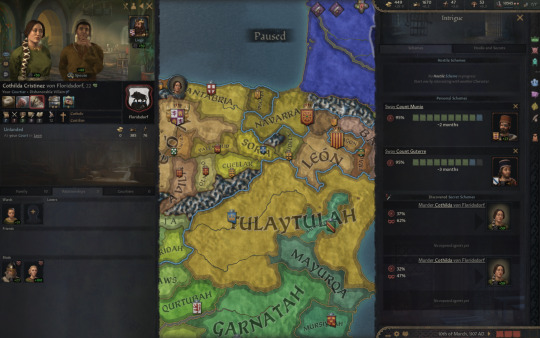
Cothilda Cristinez von Floridsdorf, who is the late King Alfonso secret bastard and currently the wife of Fernando's Court Physician Walter di Cremona, has two murder plots ongoing on her life. It can be seen how much hatred there is for her as evidenced by her 2 rivals Hartwig and Queen Joana.
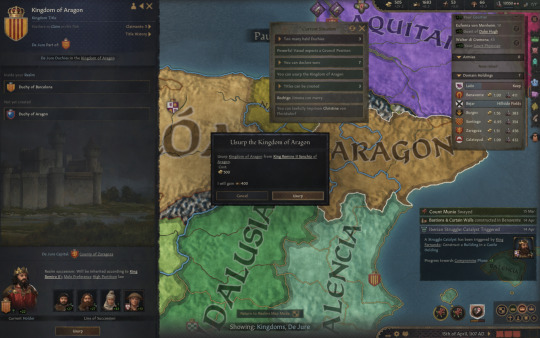
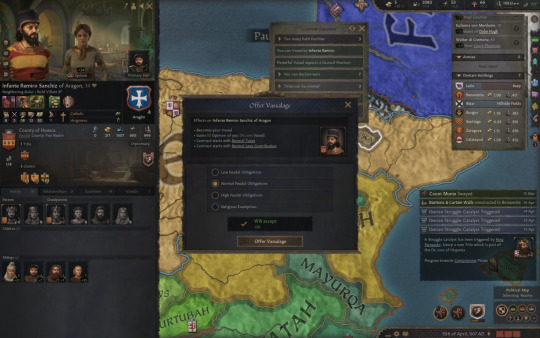
King Fernando finally decides to usurp the throne of the King of Aragon, King Remiro II, who now goes by Infante Remiro Sanchiz of Aragon with his one remaining controlled County of Huesca. In addition, Fernando vassalises him under normal feudal obligations.
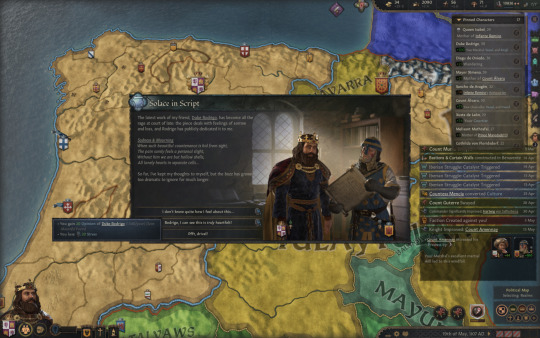
El Cid has become quite the poet and dedicated a mournful poem to King Fernando which is truly beautiful and touching. Fernando tells El Cid his thoughts that it is heartfelt, but doesn't quite know why El Cid would dedicate a sadness and mourning piece to him. Maybe it's because Fernando has many friends who recently died because of old age? Who knows...
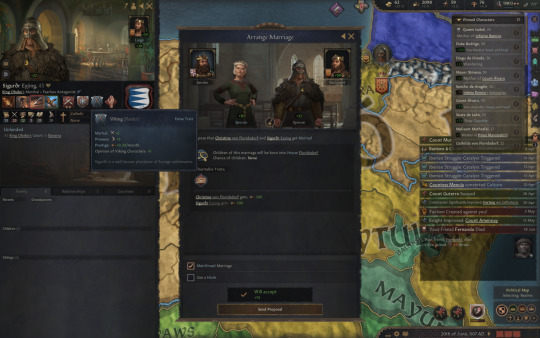

King Fernando's Antiquarian Christine von Floridsdorf's husband died recently, and thus we played matchmaker and found her a new husband in Sigurdr Eyjing who is a viking. His previous liege King Obeko of Navarra describes him as a brooding boar, but so far as long as he makes an excellent knight and fighter, we welcome him.
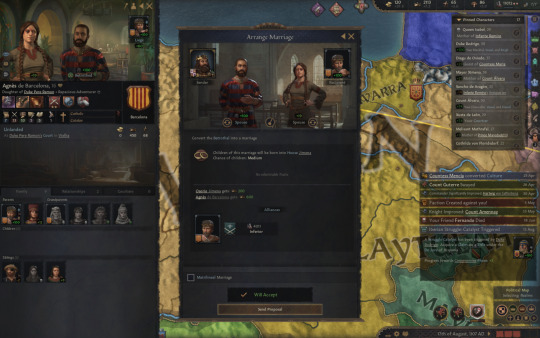
Agnes de Barcelona, the betrothed of our brother Infante Osorio Jimena has finally come of age at 16. She is also King Fernando's best friend Duke Pere Ramon's daughter. We marry them together even though she is severely injured, hopefully she recovers soon enough to give Osorio children.

I did not capture the pregnancy of Queen Joana this time, but she gave King Fernando a proper heir in the form of a beautiful son named Infante Jaime Fernandez of Leon. I did not name him Jaime it was the random naming by the game, turns out Jaime is a Spanish name with pronunciation of the 'J' as "h" sound.
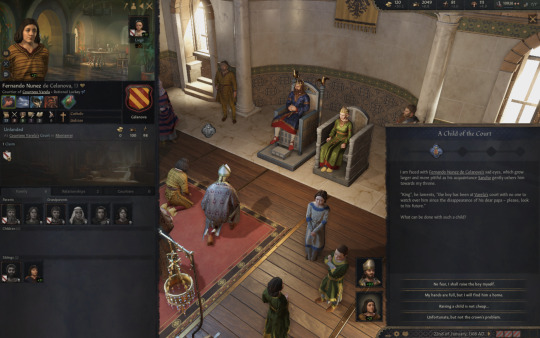
At King Fernando's royal court, there presents a 13-year old boy by the name of Fernando Nunez de Celanova who apparently lacks a guardian to take care of him. King Fernando tasks his Court Physician Walter di Cremona to look after Fernando Nunez.
0 notes
Text
Juanna la locad childhood

JUANNA LA LOCAD CHILDHOOD SERIES
The foreign candidate is Louis of Anjou (☁377), contested King of Naples, OTL husband of Joans's half-sister. It would strengthen the claim of Joana (but Martin, his son and grandson are still senior to Urgell in the genealogy of the house) and gave her a much-needed base of power. Having said that, if Joana and Mathew, with uncanny political wisdom, managed to play the Catalan élites in their favour but Mathew died childless as OTL, the logical local candidate is James of Urgell (☁380), heir to the most senior noble of Catalonia and male scion of the house of Barcelona. This contrasts with the other players of the "game of thrones" who were linked to powerful foreign royal families. A scion of a junior line of the Foix family part of the Catalan aristocracy for some generations, both his mother and his grandmother came from undistinguished families and his only cousins, the Count of Pallars and the Viscount of Cabrera, actually fought against him in 1396. Another disadvantage for Mathew and Joana : the relatively low-level genealogical connections of the Count of Foix. That did not stop Mathew of Foix to invade Catalonia in 1396 OTL, but he was easily repelled by Martin, as he did not have any local support. Finally, the queen was still in childbearing age (she was pregnant when John Ist died), so why bother to change the rules (and convince the troublesome corts to go along) ?įor all these reasons, I found it very unlikely John Ist would ever change the rules of inheritance in favour of his first marriage's daughter. He even titled his sons "Dauphin of Girona" ! Furthermore, the salic system of inheritance (as illustrated by the french laws of succession) was already installed in the crown Aragon by the will of James Ist - even if the kingdom of Aragon itself had known a female transmission. John Ist, both by personal inclination and by his second wife's influence, was very close to France. How might Aragon develop otherwise? Who might she remarry if Mathieu still leaves her without children (let's assume the problem was his, not hers) so in 1398 she's a 23 year-old widow who's also a queen of Aragón, Valencia, Majorca, Sardinia and Corsica, Countess of Barcelona. Now, what if Juan had somehow passed a law that stipulated his daughters could succeed in lack of a male heir? Or Juana had been successful in claiming the crown on her father's death in 1395. Plus, Mathieu died in '98, but Juana never remarried, and even in her own lifetime, in spite of being the senior Aragonese claimant, her younger half-sister, Yolanda, claimed the Aragonese crown. Still OTL, Juana had no children from her marriage to Mathieu, Comte de Foix, but when her father died in '95, she'd only been married to Mathieu for two years. However, Martin was having some issues with the Sicilian nobility and as a result, his wife, Maria de Luna, had to secure the Aragonese realm until he could arrive. OTL, when her father died without sons, the Aragonese crown passed to his brother, King Martin of Sicily. The Institute is continually accepting new book and edition proposals.No, not Juana la Loca, daughter of Fernando II of Aragon, but the daughter of King Juan I of Aragon.
JUANNA LA LOCAD CHILDHOOD SERIES
Reference works are published in the series RMS. Significant collections of papers appear in MISC. Published treatises include the works of influential writers from Guido of Arezzo to Jean Philippe Rameau. Significant research findings resulting from the edition-making efforts are published in the series MSD. (See CMM for sacred and secular music and CEKM for keyboard music). The scholarly editions include the complete works of major composers who lived up until the seventeenth century, composers such as Machaut, La Rue, Dufay, Willaert, Clemens, Rore, Compère, Crecquillon, Romero, and others. The publications of the Institute are wide-ranging and comprise scholarly editions, books, and treatises. Since its founding, the Institute has published more than 650 scholarly volumes including the yearbook Musica Disciplina. The publications of the Institute are used by scholars and performers alike and constitute a major core collection of early music and theoretical writings on music. Founded by Armen Carapetyan in 1946, AIM supports interest in Medieval, Renaissance, and early Baroque music.

0 notes
Text
The Education of Isabel I of Castile & Fernando II of Aragon's Daughters

"The girls received an education similar to that of the boys of the court, but they were also trained in the domestic arts, as though they were being groomed not just to be consorts to kings but to be practical and dutiful wives as well. They learned to sew, weave, embroider, and bake. Catherine famously sewed her husband’s shirts in marriage, as her mother had in hers. The royal daughters were urged to emulate their mother, who was developing a larger-than-life persona, and to similarly see themselves as warriors for Christianity. One militant melody from a cancionero, or book of songs, for example, urged Princess Juana to “follow the shining great Queen of Castile who is the fountain of virtues” and to go forward to “carry the cross” in conquest. The royal children were raised with acute awareness of their future stations and duties. In addition to receiving the general education offered to all the court’s children, the prince and princesses were also instructed in court ritual and the arts of self-presentation. They were expected to make a decorous, dignified, and impressive appearance. Specific rules were attached to their clothing, to keep them in bandbox perfection."
~ Kirstin Downey, Isabella The Warrior Queen.
#isabel i of castile#isabella i of castile#ferdinand ii of aragon#fernando ii de Aragon#show: isabel#boom quote#book: isabella the warrior queen#author: kirstin downey#education#renaissance#spanish history#katherine of aragon#juana of castile
101 notes
·
View notes
Text
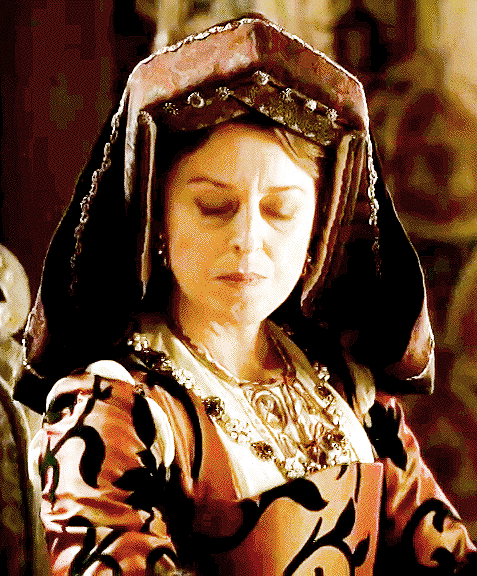
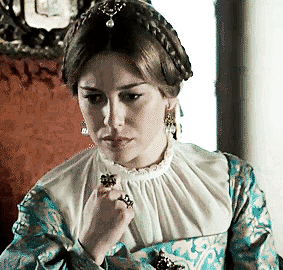

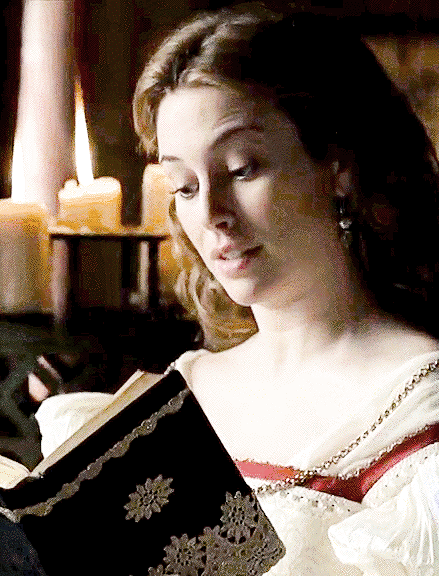
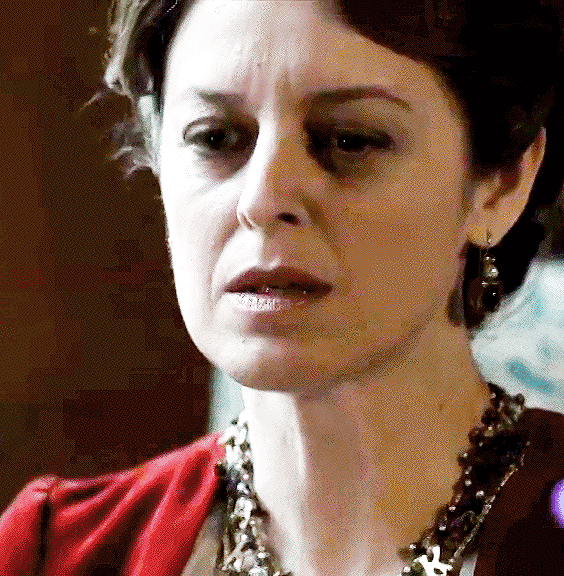

Katherine of Aragon & Isabel of Portugal
Holy Roman Empress Isabel of Portugal was interested in the case of the repudiation of her aunt the Queen of England, and she was an advocate of her cause. Katherine of Aragon knew that her nephew, Carlos V, was her only chance to defend her case successfully and that is why she wrote him. Since the death of King Fernando II of Aragon in 1516, her nephew had been her paterfamilias, the head of the Spanish Monarchy, and the most powerful monarch in Europe. Katherine played an active role as ambassadress in the Tudor court, and she was one of his biggest European supporters. Seven months after Katherine’s plead, Carlos sent a letter to his wife Isabel in Spain who was acting as his Governor during his absence. He entrusted her with a mission, to find evidence and witnesses that could help their aunt in her cause to defend her marriage.

The Empress rejoiced that her husband Carlos V was so determined to defend the right of Queen Katherine, which, indeed, it were his duty to do; not only because she was his aunt but also because the case closely concerns the Christian religion itself. Isabel sent several orders to different parts of the Iberian Peninsula to gather evidence. The first was directed to the officers in the Chancillería in Aragon to look for any legal documents related to the
marriage negotiations. Another order was sent to elaborate a list of people who were still alive and who had been witnesses in the negotiations concerning Katherine’s marriages. A second group of people were those who had accompanied Katherine to England in 1501. The third order included a questionnaire for these people that directly addressed Katherine’s virginity.
Katherine herself had written to her a full account of the case, of which copies were made to be sent to the Universities of Castile, Aragon, Valencia and Catalonia, with the orders of the Empress that the Universities are to study the case very carefully and send their opinions to her. Originals of the same shall be sent to the Emperor, and copies to Micer Mai in Rome.
In May 1531 a letter was rediscovered in Spain, written by Katherine’s father Fernando to his ambassador in Rome, Francisco de Rojas, which appeared to change everything. Katherine must have been excited to hear that it confirmed that Arthur had not consummated the marriage but that Rojas was to apply for a dispensation anyway in order to satisfy the English.
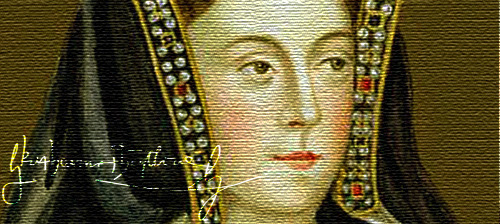
Empress Isabel was in contact with her ambassadors in Rome, France and London. Dr Pedro Ortiz, an expert in law and Lecturer at the University of Salamanca designated to defend Katherine’s case in the papal court, wrote to the Empress urging her to collect Katherine's letters as the future relics of a holy martyr. In another letter, Ortiz implored the Empress to pray for Katherine and Mary. He believed that they are in great danger.
The death of Katherine of Aragon on 7 January 1536 at Kimbolton Castle, was really sad for the Spanish Royal family. Carlos V was in Naples. By February 1, the Emperor wrote to his wife, who was acting as his regent in Spain, saying that he had heard of Katherine’s death “five or six days” previously. He told her that he and his court had donned mourning and that suitable obsequies had been performed.
Five or six days ago the news of the demise of her most Serene Highness the queen of England arrived, which I felt deeply, as you may imagine. May God receive her in Paradise, which she certainty deserved on account of her extreme goodness and virtue, and the excellent life she led. About her last illness and death the accounts differ. Some say that it was produced by a painful affection of the stomach, which lasted upwards of 10 or 12 days; others that the distemper broke out all of a sudden after taking some draft, and there is a suspicion that there was in it that which in similar cases is administered. I do not choose to make such an affirmation, nor do I wish to have it repeated as coming from me, but nothing can prevent people from judging and commenting upon the event according to their own feelings. Of the Princess, my cousin, I hear only that she is inconsolable at the loss she has sustained, especially when she thinks of her father’s past behaviour towards herself, and of the little favor she can expect for the future. I trust, however, that God will have pity on her, and will not permit the great injustice which has been shewn her to remain with- out some reparation. I have put on mourning, and ordered all the grandees around me, the high officers of this household, as well as the gentlemen of my chamber and table, to do the same, and I myself intend wearing it until I go to Rome. The exequies have been performed here as is customary in such cases; there, where you are, the same ought to be done, as this is but fitting.
Isabel felt Katherine’s death and she was surprised “by what is said of her death”, the rumors about a possible poisoning of her aunt. The Empress also received a letter from Dr Ortiz, enclosing a copy of one from ‘that glorious martyr’ Katherine herself ‘by which the Empress will see the perfection and heroic virtues to which she attained’. Katherine would be a ‘true patroness and advocate of the Empress in Heaven’.
Sources:
Amy Licence, Catherine of Aragon: An Intimate Life of Henry VIII's True Wife
Emma Luisa Cahill Marrón, Article: “Royal Sexualized Bodies at the Tudor Court”
: Questioning an Honest Queen: The Scrutiny Around Queen Catherine of Aragon's Virginity
Julia Fox, Sister Queens: The Noble and Tragic Lives of Katherine of Aragon and Juana, Queen of Castile
#catherine of aragon#katherine of aragon#catalina de aragon#isabella of portugal#isabel de portugal#english history#spanish history#women in history
26 notes
·
View notes
Photo






Catherine and the English Ambassadors
Catherine’s first appearance to English eyes was when she was present at a meeting between her parents and the English ambassadors in March 1489, at the Castilian town of Medina del Campo. The English ambassadors Thomas Savage and Richard Nanfan were here to meet the royal couple who headed what was rapidly becoming one of Europe’s most powerful monarchies, but also to cast their eyes over a tiny princess. Henry VII the founder of the Tudor dynasty would betroth his eldest son and heir, Arthur, to the Spanish royal family’s fourth daughter, Catherine. The ambassadors had spent two days at their comfortable lodgings, hung with fine tapestries, in the town. At seven o’clock in the evening, as dusk fell, the messengers from the king and queen arrived at their quarters. Two bishops, a count, the comendador of an order of knights involved in the battle for Granada and a string of other nobles, officials and ‘great persons’ appeared.
A torch-lit procession took them to the doors of the royal palace where the monarchs had established their movable court. The palace in Medina del Campo was a compact network of halls, courtyards and galleries. They were conducted into a great room where they found the kings seated under a rich cloth of gold. In the centre of this great cloth of state was an escutcheon quartered with the arms of Castile and Aragon. The monarchs both wore robes woven entirely of gold. The king’s was lined with the finest sable fur. It was the queen, however, who provoked a literary gasp of awe from Machado. The spectacular clothes and jewels she wore that evening – and the other outfits worn over the following days as the ambassadors were entertained with feasts, jousts, bull-fights and dances – were worthy, in his mind, of minutely detailed reporting. The queen’s heavy jewellery dazzled as much as her dress.
She wore on her neck a rich gold necklace composed entirely of white and red roses, each rose being adorned with a large jewel. Besides this she had two ribbons suspended on each side of her breast, adorned with large diamonds, balass and other rubies, pearls, and various other jewels of great value to the number of a hundred or more. Over all this dress she wore a short cloak of fine crimson satin furred with ermine, very handsome in appearance and very brilliant. It was thrown on [negligently] cross-wise over her left side. Her head was uncovered, excepting only a little coiffe de plaisance at the back of her head without anything else.
The formal hand-kissing and speech-making that followed was slightly spoilt by the fact that the man appointed to speak on behalf of the Spanish monarchs, the ancient Diego de Muros, bishop of Ciudad Rodrigo, had lost most of his teeth. The English visitors strained their ears, but failed to understand the Latin words that babbled past his toothless gums and out between his lips. The next twelve days of negotiating and entertainment were planned with absolute precision. The ambassadors were alternately charmed, amused, overwhelmed and conducted to the negotiating table.They also got their first glimpse of the young girl who Machado would refer to as either ‘the princess of England’ or the ‘princess of Wales’, Catherine of Aragon. The three-year-old had missed out on the jousting and banquets, though her elder siblings Juan and Isabel had danced for the ambassadors with their Portuguese teachers.
The ambassadors’ first meeting with Donna Catherine, as Machado also called her, appears to have been stage-managed to look like a simple family affair. Isabella and Ferdinand, together with the elder three children, led them into a gallery hung with fine tapestries. Here they found little Catherine and her sister María, then aged six, both as lavishly dressed as their mother. They had with them their junior court of fourteen maidens (aged fourteen or younger) ‘all of them dressed in cloth of gold, and all of them daughters of noblemen’. Catherine was still too young to dance for her visitors, but little María gamely took the floor with ‘a young lady of her age and size, and led her to dance’. The following day the ambassadors caught another glimpse of Catherine, this time in a less formal atmosphere. It was a day of fun and games, with the visitors being introduced to that most Spanish of activities, the bull-fight. Isabella brought Catherine with her to watch and, it seems, she showed herself an affectionate and attentive mother. ‘It was beautiful to see how the queen held up her youngest daughter,’ Machado recalled.
Two days later, after a hard final session of bargaining, the Treaty of Medina del Campo was signed. England and Spain sealed their alliance. The ambassadors said their goodbyes to the monarchs and little Catherine later that day, though it was the Spanish royal family who left Medina del Campo first. They were off, once more, to wander their kingdoms, though their first stop was to be a visit to Catherine’s maternal grandmother – whom Isabel visited regularly – at nearby Arévalo. The ambassadors went off laden with gifts. These included a Spanish war-horse, a smaller Moorish jennet, a couple of mules, yards of silk and sixty marks of silver each.
Source:
Giles Tremlett, Catherine of Aragon
#Catherine of Aragon#Katherine of Aragon#Catalina de Aragon#Isabel de Castilla#Isabella of Castile#Fernando II de Aragon#Ferdinand II of Aragon#María de Aragon#Isabel de Aragon#Juan de Aragon#Juana de Castilla#Spanish history#Henry VII#British history#English history
103 notes
·
View notes
Text
Lost Stars in the Night
Hi guys! So this epilogue took longer than I planned. First was that I accidentally deleted my progress and had to start all over again so that was annoying. Next was my work started to become a bit hectic thus losing my free time to write. And lastly, my grandfather died last week. The funeral was yesterday and oddly enough, after the funeral, something pushed me to really finish this epilogue. So here it is. The last piece to my most recent writing project. Thank you again for reading this! I truly appreciate each and every feedback given.
The following characters belong to:
Isabella I of Castile, Ferdinand II of Aragon, and Juan Trastámara: @weirdbutdecentart
Isabella Trastámara: @lexartsstuff
Marion Trastámara and Elizabeth 'Liz' Seymour: @vanessaseymour
Juana 'la loca' de Castile: @ellielovesdrawing
Maria Trastámara, Maria of Jülich-Berg, and Sibylle of Cleves: Yours truly
.
Characters (Description and characters change with each chapter):
Catalina Trastámara - Age twenty nine years old. She's the captain of the expedition team six whose goal is to scout areas to see if they are suitable for expansion. Her years-long goal has been to locate her father's main office to find answers about the vaccine he had given her when she was just a toddler. She wanted to find the formula so they can replicate it and distribute it to the survivors. She's currently in a relationship with Jane Seymour and has three children from a previous relationship.
Anne Boleyn - Age twenty seven years old. Her family came to Campamento Zaragoza when she was ten and has stayed there since. She's the vice captain of the exhibition team six though she often takes charge alongside Catalina rather than taking charge when Catalina is absent. The two had a rocky start given that Anne was the woman Catalina's ex cheated on her with but the two eventually became close friends. Often bonding over their useless ex. She's currently in a relationship with Catherine Parr and has a daughter from a previously mentioned ex.
Jane Seymour - Age twenty six years old. She's a member of the expedition team six. She's mostly the voice of reason of the group and somewhat of a mother hen. Always fussing over her teammates to make sure they're okay. She and her older sister, Liz, have been living in Campamento Zaragoza since most of her life. She's currently in a relationship with Catalina Trastámara and has one son from the same ex Catalina and Anne shared.
Anna La Marck - Age twenty six years old. She's a member of the expedition team six. Often referred to as the 'muscle' of the group, she's usually the one taking action first when it comes to conflicts the team encounters. She was born in the early months of Campamento Zaragoza's life span and has lived there since then. She's currently in a relationship with Katherine Howard, having been best friends for years as they grew up together.
Katherine Howard - Age twenty five years old. She's a member of the expedition team six. She's the youngest member of the team and is their go to mechanic when they have vehicular troubles. Just like Anna, she was born in Campamento Zaragoza and she's currently in a relationship with Anna La Marck, having been best friends for years as they grew up together.
Catherine Parr - Age twenty seven years old. She's a member of the expedition team six. Considered as the informant of the group. She's usually the one going head first into research when they need information on something. She has one daughter from a previous relationship and i's currently in a relationship with Anne Boleyn.
Isabella Trastámara - Age forty four years old. She is the acting head of the camp alongside her wife. She took up a leadership position after her mother and she's been running the camp ever since. She followed in her mother's plan of land expansion and was quite successful over the years with the camp expanding as far as Girona and they added fishing to their agriculture sector. She and her wife, Liz, adopted a baby boy when his mother died giving birth to him.
Elizabeth ‘Liz’ Seymour - Age forty four years old. She is the acting head of the camp alongside her wife. She retired from her captain position after many years but she still represents the expedition and patrol sector as its head. She and her wife, Bella, adopted a baby boy when his mother died giving birth to him.
Juan Trastámara - Age thirty six years old. Married to Margaret Habsburg and they have a little three year old girl they named Isabela after his departed grandmother. He's working in the armory division designing and creating wearable protection that the border patrollers and security division wear.
Juana Trastámara - Age thirty five years old. She was married to Margaret's older brother, Philip, who abused her for years until he was killed in battle. Their marriage resulted in six children that she fiercely protects with her life. She's currently in a relationship with a woman named Harley Harmony. She's a member of the security team and often patrols the streets with her team.
Maria Trastámara - Age thirty two years old. She's currently in a relationship with their long time partner, Gabriel Cursae. Her knack for mathematics got her the position of head of the inventory division and is responsible for keeping track of the camp's main inventory numbers.
Marion Trastámara - Age thirty two years old. He's currently in a relationship with William La Marck, Mari and Johann's third child and only son. They work as Campamento Zaragoza's only tattoo artist. His most common customers are those from the fighting sector and their most commonly commissioned pieces are portraits and names of departed loved ones. His proudest work is the Trastámara family crest that they tattooed on himself and their siblings.
Jocasta ‘Joyce’ Howard - Age fifty five years old. She's Kat's mother and she works at the hospital as a midwife alongside Mari, who's a nurse in the maternity ward. She's kept her daughter in the dark when it comes to her life before the End.
Sibylle La Marck - Aged twenty eight years old. She's engaged to Katherine James, who now runs the nursery. She's a member of the security team and often patrols the main gates with her squad.
Katherine James - Aged twenty six years old. She's currently engaged to Sibylle La Marck and she's a caretaker at the nursery after inheriting it from her mothers. Despite being and actual Tudor, she kept the last name, James, since she was raised by both her adopted mothers.
Henry 'Hal' Trastámara-Tudor - Age ten years old. He's Catalina and Henry Tudor's oldest son. He was named after his own father but looks more like his mother. He started despising his name after his father hurt and cheated on his mother so he prefers going by his nickname. He replaced his father by becoming his sisters' male role model.
Mary Trastámara-Tudor - Age seven years old. Catalina and Henry's second child. She's what you call a 'daddy's girl' but that label suddenly became useless after her father left them. She was still hoping her parents would get back together but stopped when her mother introduced Jane to them and she's stopped looking for her father since. Perfectly content with having Jane as a second mother.
Lillia Trastámara-Tudor - Age three years old. Catalina and Henry's youngest child together. She's her father's 'least favored' child due to her physical defects. She was born blind in one eye and her right hand didn't develop fully. Henry blamed Catalina for birthing a child with defects and unfortunately, little Lillia heard those arguments between her parents and blamed herself for them eventually splitting.
(Before you proceed, be warned that the story contains graphic descriptions of violence, blood, gore, death. Please proceed with caution)
------------------------------------------------
Epilogue
Catalina cries out when the nurse inserted the needle in her arm. Fernando held his youngest steady so she wouldn't squirm and injure herself with the needle. The nurse praised the toddler for being good after she had pulled out the needle and put a cartoon band aid, the tot had chosen prior to the shot, over the injured area.
"I'll submit the report to the department head. I'll also schedule the second dose six months in advance for you. Gracias for coming here, señor," the nurse said and left the room.
"Look at you, pequeña! You're quite brave," her father praised. Handing her precious Pancho back to her. She immediately took the plush monkey and hugged it close for comfort.
"Papa. It hurt," she whines. Gently rubbing the arm that received the shot.
"I know, pequeña, but you were brave and I'm proud of you for being a brave girl," Fernando reassured. Kissing his daughter's forehead.
Catalina pouts and pushes him away. She jumped off his lap and marched to the corner. She sits down on the cold tile floor, crosses her arms over her chest, and glaring at her father. Fernando knew that she was displeased with him. Luckily, he knew just the offering to get back to her good graces. But first, he must test the waters.
"Catalina."
The toddler lets out a 'humph' and looks away.
"Catalina, mi pequeña preciosa."
"Humph!"
Time for bribery then.
"Would you like to go to the ice cream shop for your favorite mango ice cream?" Fernando offered. He smiled when the toddler slowly turned to look at him.
"Mango ice cream?" she asked with a tone of hope in her voice.
Her father smiled and nodded. "Mango ice cream," he confirmed.
Catalina grins wide and stands up from the floor. She runs over to her father and tackles him in a hug.
"Ice cream!" she excitedly said.
Fernando chuckled and lifted his pequeña Catalina up in his arms.
"Let's go get some ice cream but don't tell mamá where we went, okay? It's our secret," he reminded.
The toddler nodded and hugged her father's neck as they exited the room.
.
Name: Catalina Trastámara
Age: 3 years old
Sex: Female
Height: N/A
Weight: N/A
Blood Pressure: N/A
Consent from subject's guardian: Approved
Vaccine dosage: N/A
Vaccine side effects: none so far
Vaccine effectiveness: Yet to be determined though the subject has shown immunity to the virus when exposed to a very small dosage of it.
Examiner's Note: The subject's immunity seems to have developed significantly after being given the latest vaccine. It's not perfect but it's better than the last one which was given to the subject's older siblings. Further examination needed.
Catalina shuffled the papers. Rereading everything again. She's known for years that her father had her and her siblings vaccinated against the virus that brought over the End but only her records were left in the laboratory. She couldn't find anything about her older siblings.
The letter her father penned to her stated that the vaccine given to her was the updated one and far more effective but she wasn't sure of that and she's not willing to get herself bitten by an Infected to find out.
Sure the numbers had dwindled significantly over the years but it's better to be on the cautious side.
"Lina, we found more in the other room."
Catalina puts the papers back in the folder where she found them and safely put them away in her backpack. One of her teammates and vice captain, Anne Boleyn, walked over to her and handed her more papers. Catalina quickly skims them over. Then she noticed something about them.
"These are…these are documents for developing the vaccine," she said. Quite surprised that they've found it already.
"Yep. It states the components and process needed to make the vaccine," Anne said. A smile on her lips.
Catalina couldn't help but get emotional. After years of searching for her father's headquarters, they finally found the very thing that can make the world right again.
The world can finally heal and humanity can start over again.
"This is exactly what we came here for and we've got it. Let's head back and give this to Bella," she said. Putting it in a secure folder and tucking it in her backpack. Her old friend, Pancho, strapped snuggly to it.
"I'll gather the others so we can leave. Let's meet up outside," Anne said and left to go find the others.
Catalina decided to do a bit more investigating. She exits the lab and makes the long trip up the flight of stairs. She wanted to see her father's office. To see if she could still remember what it looked like the last time she's been there. She finally reached the executive floor and she had to catch her breath for a minute after climbing up several flights.
"Really wish the elevators were working," she mutters to herself before exiting the fire escape and entering the floor.
It wasn't hard to locate Fernando's office. It was easily the one with the large double doors bearing the Trastámara family crest.
"Bella did say that papá was always extra."
She pushed the old door open and inside was a time capsule. Except for the thick layer of dust, and a bit of decay, everything was exactly the same. As if her father hadn't died at all. Catalina enters the office and looks around. She remembers visiting this office with her mother and older siblings. She remembers playing on the carpet with her beloved Pancho and sitting on her father's lap while he worked. Letting her press the enter key or the space bar from time to time.
Catalina walked over to the executive desk and used a discarded paper to wipe off the layer of dust. She traced the wood until she felt the small, barely visible carvings on the wooden surface. She smiles to herself as the memory of her swiping her father's keys and using them to carve out her name on the wooden desk. Fernando scolded her for damaging his very expensive desk but he never did replace it.
"I think he would've framed it if he had the chance," Catalina said to herself. Chuckling softly.
Something else on the desk catches her eye. It was several small framed photos. She reached out for one and wiping away the dust on the glass revealed a family photo.
Catalina immediately recognized herself as the little toddler in the photo. Bearing a wide and happy grin at the camera with Pancho clutched in her arms as she sat on her father's lap. She recognized her older siblings as well. Juan and Juana sitting next to each other and the twins, Maria and Marion, sitting on their mother's lap. Their oldest sister, Isabella, sat between their parents. Happy smiles all on their faces.
Those were the days.
She looked towards the other framed photos and wiped the dust off each one. Her father kept framed photos of her, her older siblings, and his wedding portrait with their mother. She noticed that the wedding photo had the most elaborate frame out of all the photos. The frame seemed to be made of real gold. Worthy of such a powerful couple at the time.
"I never knew you personally, papá. I only had the memories of you in my early childhood as well as Bella's stories about you. I wished I knew more," Catalina said. Staring at her father in the wedding photo.
She grabbed all of the framed photos and put them in her bag. She also grabs an expensive-looking pen from one of the drawers that bore her father's signature on the cap. Making sure they're secured in her bag before sling it over her shoulder. She heads to the door of the office to leave but before she exits, she looks back and says, "Adios, padre. Te querio." She exited the office and closed the door behind her.
.
"So what took you so long in there, Lina?" Anna asked as she sat in the truck's passenger seat. Right next to Kat, who was driving.
"I went to my father's old office," Catalina answered as she sat next to Jane.
"Found anything useful?" Cathy asked as she read through the other papers that they had found. Making mental notes that she'll transfer to her notepad once they arrive home.
"Well…I found some old photos of me and my family plus his favorite pen."
"I'm sure your siblings would love to see those, darling. Especially Bella," Jane said. Smiling at her girlfriend and placing a hand on her knee. Catalina smiled gratefully at her.
"It's strange, really," Anne said. "We all grew up in a dying world, trying to revive it without even knowing what it used to be before the End.
"Yeah. We're making all this effort and yet we didn't grow up in a normal setting like our parents did. We only have their stories as a basis," Kat agreed with her cousin.
"And foggy memories," Catalina added.
Anne looked over to their team leader and a question popped up in her mind.
"What was your family's story, Lina? Before the End," she asked. Voicing the question.
"Me? Well for starters, I remember my family being rich. Like living in a large mansion and such. Both my parents run their own successful and well known companies. In fact, I remember that my parents were about to head to work when the End happened," Catalina recalled. Still remembering that very day like it was yesterday. She even remembered her breakfast that she had that morning. Fried egg sandwich with mayonnaise, cheese and the bread toasted perfectly. Pairing it up with a cold glass of her favorite mango juice.
A fitting last supper for a child her age at the time.
"Same thing with my parents. They came from rich families in Germany though I was told that they were disowned when they had my sister, Sibylle," Anna contributed.
"I remember your parents telling my madre that they were just about to finish university when the End happened," Catalina added.
"I was told that my family was mildly rich back in France. Like not millionaires per se but we can afford a couple of fancy cars, private schools and things like that," Anne said. She still remembered France a bit but not that much. All she knew was that she was quite fluent in the language despite not remembering living there as much.
"My mum wouldn't say anything about our family so I don't even know who my dad was or if I had older siblings or not. I just know that she was, and is, a midwife," Kat said. She remembers her mother would have this sad look on her face whenever Kat would ask about her father or possible siblings. She decided to drop it after Joyce had snapped at her to stop asking about it.
"I recall my madre finding your mum at a petrol station convenience store while we were on the road to escape the herd," Catalina commented.
"Oh yeah. She told me about that one plus the dog bite that was mistaken as an Infected bite incident."
"I was told my family was like upper middle class. My dad used to be a police chief in London and my mum recently graduated with a nursing degree before the End," Cathy said. Not really remembering about London much since she was just a baby and she and her parents had already gone to Spain for a vacation when the End happened.
"Liz only told me what she remembered about our family home. Not much about our family in general. I knew I had many siblings and that we used to live on a ranch with horses and such. Though she often tells me stories about the man that took us in at the peak of the End," Jane said. She vaguely remembers Gonzalo but she knew him enough from the stories Liz tells about him as she was growing up.
"You mean my godfather?" Catalina asked.
"Yes. I think his name was Gonzalo, right?"
She smiled and nodded. She doesn't remember her padrino quite well but her older sibling's stories about him makes her think that he was truly a kind man who was harshly taken away from this world.
"I've heard about the story of your uncle, Lina. The first leader of Camp Zaragoza. Was he really a murderous psychopath?" Anna asked.
"He was my half uncle. And yes. Bella told me all about what he did to my family. Especially my madre," Catalina said.
"Eesh. Thank god my family came later long after he died," Anne said.
"Thank god we were too young to know and experience his tyranny," Cathy added.
Catalina was silent for a moment. Then she said, "he killed my grandmother, my grandfather, my godfather, and tortured my mother and sister."
"Oh…sorry," Cathy quickly apologized.
Catalina shook her head. "No. It's okay. It was all in the past. Though I still remember my mother having really bad nightmares after. She would come to my room and lay next to me and would cry herself to sleep," she said.
"Oh my god…," Kat muttered.
"I'm so sorry, Lina," Jane said.
"Sometimes I wish I could have done something back then to make her feel better…"
"Well, if it helps, you found the formula that could make the world better again," Anne said.
Catalina looked at her and nodded gratefully.
"Yeah."
.
The group arrived back at the main camp and the gates opened to let them in.
"Glad you all came back safe," Sibylle said as she approached her sister and her group. She and Anna shared a hug and gave each other pats on the back.
"You bet we did. Not much Infected roaming around these days anyways," Anna said.
"And just in time for mutter's birthday too," Sibylle said.
"Oh that's right! Kätzchen, let's stop by your mum's place first before going to mutter, ja?" Kat smiled at her girlfriend and nodded. "Sure!" she said.
"I'm going to Bella's office to deliver the goods. Cariño, can you do me a favor and look for my other siblings? Tell them to go to Bella's office once you find them, Catalina said.
Jane smiled. "Of course, darling. I'll be sure to do that before I pick up Eddie," she said.
The leader of the group smiled gratefully then left for her oldest sister's office.
.
"Welcome back. How was your expedition?" Isabella asked as her youngest sister entered her office.
"See for yourself," Catalina said and placed the folders on the desk in front of her eldest sister.
Isabella and her wife, Liz, looked through the papers. Then the two shared shocked expressions when they realized that what they were holding was the bible of the very vaccine they've been looking for.
"Oh my god…this is actually the formula!" Liz exclaimed.
"It's probably outdated by now but it's enough of a basis to use to create our own stronger vaccine!" Isabella said.
"Great job, Catalina! I'll bring this to the lab immediately!" Liz said. Gathering the papers and hurrying out.
Isabella smiled at her sister and hugged her. "This is a great start to making things right again! Muchas gracias, Catalina," she said. Catalina smiled and hugged her back then pulled away. "I actually found something else there too," she said. Grabbing her bag and rummaging through it.
"What else have you found?" her sister asked.
The youngest of the Trastámara children laid out the framed photos one by one on her sister's desk. Isabella looked at them. Her tears welling up with each photo she sees. She started to sob quietly when her eyes laid upon their parents' wedding photo.
"I found these in the papá's office. It was still the same as I remember it. Only a bit dusty," she said.
Isabella picked up their framed family photo and looked at it. Smiling sadly at the happy faces of her family.
"I miss those days. Those days where all I worried about was what university I should attend after graduation. I often wished I went to Madrid University like mamá and papá did," she lamented.
"You never told me. What really happened to papá," Catalina said. Looking at Isabella.
The older of the two wiped her tears away and looked down. She carefully placed the framed photo of their parents on her desk. Moving it next to hers and Liz's own wedding photo.
"Papá was bitten by an Infected. He had died and came back as an Infected and attacked mamá. Mamá had no choice but to shoot him," she recounted. Still slightly bitter at her mother for keeping this fact a secret.
"And mamá hid that fact for a long time?" Catalina asked.
Isabella nodded. "She did. I was mad at her for lying to me but…later on I realized she did it to keep us together to survive. Lord knows what would have happened if she had told me that she shot papá. I would have left with you all in my car and…probably not survive that long," she said.
"The herd would have mostly gotten to us."
Isabella nodded. "It was mamá plans that got us through those hellish and dangerous months when the herd reached Campamento Zaragoza," she said.
She remembered it as if it was only yesterday. They had finished the fortifications of the walls and secured every inch of the territory. The herd had arrived some days after they had finished and everyone lived in fear for several months. No one could go out to scavenge. They were all trapped inside behind tall walls and had to rely heavily on their existing resources. They even considered opening fire on the herd but wasting ammo was not a viable option. Isabella had to do her best in keeping everyone calm during those months and wisely ration their resources. Thankfully, their crops survived through the months. The herd itself died out slowly as the Infected rotted away until there were only bones left. The strong stench of rot caused a lot of people to be sick and the leadership council needed to have oxygen masks made for the people. Especially those vulnerable.
"What I hated during those months was the stench. I probably threw up every day during that time and got sick often," Catalina said. A look of disgust on her face as she remembered the memory of her youth during those times.
"Well hey at least you got through it," Isabella pointed out.
"Yeah but I probably lost my sense of smell for a long while after."
Isabella chuckled. She reached up to ruffle her sister's hair but Catalina nimbly ducked away and stuck her tongue out at her.
"You're so childish, Catalina," she said. Grabbing her by the shoulders and rubbing her knuckles against her head.
"Ah! Bella no!" The youngest cried. Struggling to get out of her sister's grip.
Isabella laughs and finally releases her. Catalina pouted as she fixed her hair. "And you say I'm childish," she retorts.
"We all are in a way. It's nice to act childish once in awhile," the older of the two said. Catalina smiled and nodded in agreement.
A knock on the door broke the brief silence the sisters shared.
"Come in." Isabella called. Going behind the desk and sitting down. Business as usual. The doors opened and Juan peeked in. "You called for us, Bella?" their brother asked. Entering the office with the rest of their siblings behind him. Isabella frowns in confusion.
"No I didn't," she said.
"Actually, I did. I had Jane call you and the others up here," Catalina said. Her older siblings looked at her in surprise.
"What for, Lina?" Maria asked. Standing next to her twin.
"I wanted to show you what I found in papá's office," she said.
This immediately got their attention and they crowded around the table. Looking at the photos of their family.
"Oh my god…I never thought we'd see these again," Marion said as they looked at the framed family photo. It was the last one they took before the End happened.
"And papá kept all of these in his office…," Juana whispered. Tracing the features of her younger self.
"Wow…I…I'm starting to get emotional…," Juan said. His voice cracked a bit.
"It was quite emotional for me too. Being in his office earlier. It was still the same as I remembered it. Like he never left," Catalina said.
The siblings had an emotional moment together. Huddled in a large group hug and reminiscing the years of innocence that were harshly taken away from them when the End occurred.
"I love you guys. I couldn't imagine a life without any of you. Even though you guys drive me up the wall sometimes," Isabella said. Earning her a laugh from her younger siblings.
"You'd probably be a spoiled only child without us," Marion quipped.
"Yeah but I ended up spoiling you guys instead," his oldest sister said.
"Such is the life of the oldest child," Maria remarked.
"Here here!" Juan said. The siblings shared another laugh.
The six of them stayed in Isabella's office for awhile. Just talking and reminiscing the past years they've had together.
"Mamá really did everything to give us the life she would have wanted. Even at her expense," Marion said. Their siblings nodded in agreement.
"We wouldn't have made it this far without her," Juana said.
"Yeah," Maria said.
"Speaking of mamá, I should get going. I haven't seen my children yet since I came back here after arriving back," Catalina said. Grabbing her bag and packing the framed photos in it.
"You're going to the farmhouse after?" Juan asked.
"Yep. I'm taking a well deserved vacation after the expedition," the youngest said. Slinging her backpack over her shoulder.
"Alright then. I'll just communicate the reports to Anne," Isabella said.
"Thanks Bella. I'll see you all in a week."
"See ya!"
.
Catalina arrived at the day care and got out of her truck. She was about to head inside when someone called out to her.
"Catalina!"
She turns and smiles when she sees Joyce heading towards her.
"Hola, señora," she greets. "Looking for Kitty?"
"Oh I already met up with Katherine earlier. She and Anna are currently headed to the hospital to surprise Mari," Joyce said.
"Oh that's right! Today's her birthday, right?"
Joyce smiled and nodded. "I think they'll be holding a party later. Anyways, I wanted to ask you a favor and it's okay if you refuse," she said.
"We'll see then. Fire away," Catalina said.
"Do you still remember the petrol station where your mother found me?" Joyce asked.
"Somewhat. I think we pass by that particular station a few times during our expeditions. Why?" Catalina asked.
"Well on your next expedition, I was wondering if you could stop by the museum near that petrol station and take Katherine there. That's where I…I lost my family," she sadly explained.
"Oh. I see. Well, I'll be sure to make a short pitstop there for Kitty." Joyce smiled gratefully.
"Thank you, Catalina. Katherine's been asking about my family for years and I feel bad for keeping it away from her. She deserves to know. Hopefully their belongings are still there."
Catalina nodded in understanding. Kitty has told the group many times how she'd want to know about her own family but her mother was still grieving them after all these years.
"I'm heading off to Girona later. I'll stop by and check if I find myself down that path," Catalina reassured.
"Thank you again. I'll see you around, Catalina," Joyce said.
"De nada, señora."
Joyce gave her a small hug before heading off on her way again. Catalina watched her go with a sympathetic smile. From what Isabella had told her, Joyce was the only survivor of her family when they found her. So it was understandable why she's still grieving and refused to tell Kitty anything about them.
She made a mental note to herself to stop by that particular petrol station sometime.
"Mama!"
As soon as she comes in, she grins and opens her arms to catch her children as they tackle her in a group hug. Ten year old Hal, seven year old Mary, and four year old Lillia all laughed happily as they piled on their mother.
"You're back!" Mary said.
"Yes I am! I just got back earlier. Have you three been good while I was gone?" their mother asked.
"Sí! We missed you though," Hal said.
"Miss you so much!" Lillia added.
"Oh I missed you too, mi niños!" Catalina said. Pulling her children closer. Then she looked at the three of them with a small frown.
"Did your father come and visit you while I was gone?" she asked.
As she expected, all three of her little ones shook their heads with sad faces. Their father was notorious in making empty promises after all.
"Of course he didn't. He's probably with his latest side fling of the week," Catalina mumbled.
"Welcome back, Lina! Glad you guys made it safe," Kath said. Walking over to them with a smile on her face. Catalina smiled back as she stood up.
"Hola, Kath. Thank you for looking after my little rascals here," she said.
"No problem! They behaved as usual so it was no trouble at all," Kath said.
"Did your brother visit them at least once?" Kath shook her head.
"Nope. He didn't even visit Elizabeth and Edward. But what did you expect from my useless brother?"
"Nothing. There was nothing to expect from him. Though it's probably for the best that their father isn't in their lives to influence them. Well we better get going. Thank you again, Kath!"
Kath smiled and nodded. Catalina took her children out of the nursery and got them in her truck.
"Can we go to the farm today, mama?" Mary asked.
"Yeah! We go swimming!" Lillia said.
"We are going there, niños. We'll be staying there for a week," Catalina said. Getting in the driver's seat.
"Yay!" the three cheered. They loved going to the farm. Especially when it was close to the beach and they could all go swimming, fishing and go dig in the sand to hunt for crabs for dinner.
"Let's stop by the house first to pack up," their mother said and drove off to their humble home.
To her surprise, Jane was already there when they arrived and had already packed their things for them.
"Cariño? When did you get here?" Catalina asked. Urging her children to their rooms to get their bags. The blonde smiled at her and said, "I heard you're going to stay in Girona for a week so I thought I'd pack your bags in advance and house sit for you while you're gone."
Catalina chuckled and gave her a swift kiss. "You somehow always know things in advance," she commented.
"It's a talent," Jane said. Cuddling close to her girlfriend.
The couple stood in silence for awhile, just holding each other close. Catalina broke the silence first.
"Jane."
"Hm?"
"What do you think about moving in together?"
Jane looked up at Catalina with a happy grin. "I would love to move in with you!" she happily said.
Catalina grins back and the two share a loving kiss. "The move will be easy since the children already get along quite well. Why don't you and Eddie move in completely once we get back from Girona?"
The blonde nodded. "I would love that!" she said. The Spanish woman smiled again and gave her another kiss.
Things really are starting to turn out for the better.
.
Catalina parked her truck in front of the old farmhouse and got out. She helped her little ones down from the vehicle and they walked up to the front door. She unlocked it with her key and went in. Hal, Mary, and Lillia immediately rush upstairs to get to their rooms and unpack.
Meanwhile, their mother went to the living room and towards the homemade altar. She pulls out the framed photos from her bag and carefully places them there.
"I didn't hear you come in."
Catalina smiled. "I didn't want to wake you and I'd thought I'd surprise you," she said. Turning around to face her mother.
Isabel smiled as she hobbled over her youngest. Leaning heavily on her husband's old cane. The left sleeve of her shirt was dangling about with each step. Catalina went over to her mother and hugged her.
"The little ones woke me with their excited chatter, but you still managed to surprise me. How was the expedition?" she asked. Pulling away and turning towards the altar. Her eyes widened at the sight of the framed photos. She let go of the cane in favor of reaching out to one of the photos, her wedding photo, and taking it in her hand.
"H-How did you…?"
"We found the formula for the vaccine but I also found these in papá's old office. It was untouched all these years," Catalina said. Going around and picking up the dropped cane.
"Oh Fernando. Mi amor. You were always the sentimental one out of the both of us," Isabel muttered as her thumb gently traced over her late husband's features on the photo.
"I can take you there sometime. See his office and all," Catalina offered.
Her mother shook her head. "The past has passed. I buried your padre a long time ago in our old home. It wasn't a proper grave per se but he would've wanted it if there were no other available options," she said. Gently setting the photo down.
"Mamá…the others and I are planning on traveling home next month and we'd like you to come with us," Catalina said.
Isabel looked at her daughter in confusion. "Traveling home?" she asked. Her youngest daughter nodded in confirmation.
"Sí. Back home to the mansion. Pick up some old things we left there for sentimentality. Maybe even pay our respects to padre."
Isabel thought for a moment. Going back home after all these years sounded great but she's not sure if she's ready to go back yet.
"I'm not so sure, mija. It's been some decades since we left the mansion," she said.
"I know but it'll be nice if you'd come with us."
"I'll…I'll think about it, mija. I'll be sure to give my decision when the time is right."
Catalina gave her mother a small smile before handing her the old cane back. Isabel quietly thanked her. Taking the cane and leaning against it for support.
"Let's go sit and talk. I haven't seen you in weeks," she said. Hobbling over to the couch. Catalina followed right behind.
Isabel carefully lowered herself to sit on the couch with a slight groan. Her daughter went to help her but she waved her off and sat down heavily with a sigh.
"You're having trouble sitting again. Maybe you should go to the camp to get your back checked," Catalina suggested. Sitting next to her mother.
Isabel shook her head. "No. I don't want to," she said.
"But why? The doctors can help you."
"Ever since I got bit by an Infected years ago, a bit of the virus is still in me. Even after I had to cut a part of my arm off entirely. There's no cure for me, Catalina. I just have to live with it."
Catalina couldn't help but look at the stump of an arm her mother has. She could still recall that very day. Her mother had stumbled back in camp with her entire forearm cut off. She was pale, bleeding heavily, and a bit of bone was sticking out through the open wound. The hasty patchwork she did on the stump is probably what saved her just in time. She got to drive back long enough before she could pass out from blood loss and got her severe injury treated just in time.
"What was it like? Cutting your own arm off?" Catalina asked. She's been curious since the incident but didn't have the courage to ask.
Isabel lets out a chuckle. "Why? Planning on cutting a certain body part of yours in case of an Infected bite?" she joked. Her daughter chuckled as well.
"Maybe when I'm desperate enough. Right now, I'm just curious. What was going through your head that time? What made you do it in the end?" Catalina asked. Isabel grew serious and looked down at arm. Glaring at it.
"Mamá?"
"I thought of you."
Catalina was surprised at the answer. "Me?" she asked. Pointing at herself. Her mother nodded in affirmation.
"Yes you. You and your siblings are what made me do it," Isabel said. "I realized that Bella couldn't take care of you all by herself if I was gone. Plus, I knew they would make her my replacement when she wasn't even ready yet. It was hard enough without your papá but without me…she, as well as the rest of you, wouldn't be able to have the life you have now."
Catalina nodded. It does make sense. Even though Isabella was eighteen at the time, she's still somewhat of a child herself. Needing guidance to get through adult life. So sacrificing a part of an arm was a small sacrifice in order for Isabel to live and be the guide her daughter needed. The youngest Trastámara was snapped out of her thoughts when her mother suddenly chuckled again.
"Care to share what made you giggle like a niña?" Catalina asked. Playfully raising an eyebrow at her mother.
"I just realized that cutting my own arm at a church altar made it look like I was offering a blood sacrifice to the Lord. Though in a way, it is somewhat like that. I was praying for God to save me and have mercy on me while screaming in pain," she casually said.
Catalina looked at her mother with a horrified expression. The mental image of her mother severing her own arm off made her a bit disturbed and nauseous. "Lo siento, mija. I didn't think that the image would be disturbing to you," Isabel apologized after noticing her daughter going a bit pale.
"Mamá…why? Why not try another way?" her daughter asked.
"I was scared and desperate. I was alone with an Infected bite on my arm and a blade. I wanted to live and, by God's will, I will live. For the sake of the only family that I have left," Isabel said. She pulled the old blade out from the cane. She could still see the part that she used to cut off her arm. The sharp edge chipped when she got to the bone of her forearm. Catalina placed her hand over her mother's and gently pushed the blade back in the cane. Isabel sighs and sits back on the couch. The youngest child looked at her in worry.
"Can I tell you a secret?" she asked. Catalina paused for a second before nodding. "Go ahead."
"Promise me you won't tell any of your siblings. Especially your hermana."
"Okay."
Isabel closed her eyes briefly, took a deep breath to gather her courage and faced her youngest fully.
"I've been feeling bouts of severe pain in my arm since the bite and had some sort of addiction to painkillers," she said. Placing a gentle hand on her amputated arm. Catalina looked at her in shock.
"Mamá! Why didn't you–" she exclaimed.
Isabel held up a hand to cut her off from saying more. "I didn't want you all to worry. So I kept it to myself and smuggled small doses of painkillers from the medical inventory during weekly counting to bear with the pain and show that I was fine," she explained.
"But mamá, keeping such a large secret from me? From the others? We could have helped you!" Catalina said.
"That's the problem. You couldn't," Isabel said. Her daughter looked at her in shock. "Not even I couldn't help myself. I tried other methods. Trust me, I did but the pain was unbearable and pills were the only temporary solution. I didn't want you all wasting your time worrying over something you can't fix instead of focusing on your own lives. So I decided to keep it all to myself and let my children live their lives with no worries or distractions. Especially from their madre."
Catalina had tears streaming down her face. Her mother had been feeling excruciating pain for years and she couldn't do anything about it. She felt somewhat betrayed. Isabel smiled reassuringly and wiped the tears with her thumb before pulling Catalina close to kiss her forehead.
"I'm happy I kept it from you. I didn't want you all to worry about me. Especially when you were still growing into people you wanted to be," she said. Pausing a bit to collect herself as she was fighting back her own tears. After a few deep breaths, she continues, "I never really had a childhood. My mamãe, your avó, had early onset dementia and I had to take care of her when your abuelo Chacón wasn't present. At the same time, I was studying and taking care of my younger brother as well since he was still a child and mamãe couldn't really take care of him. I didn't want you all to go through that. You deserve better."
"Mamá, we could've found a way to help you! Don't you trust us?" Catalina asked. Sobbing once more. It truly hurt her to learn that her mother was suffering for their sake. Isabel smiles at her daughter again.
"I do. I trust you all but there's just some things that a mother has to keep in the dark to protect her children. While I had no regrets in taking care of your avó, I still longed for the childhood I never had," she said.
Catalina couldn't take it anymore. She pulls her mother in her arms and hugs her tightly. Isabel wrapped her one good arm around her daughter and gently rubbed circles in her back to comfort her while Catalina cried on her shoulder.
The mother and daughter stayed like that for a good while. Only pulling away after Catalina had run out of tears to cry. She wiped away the tears as she recomposed herself while her mother sat back against the back of the old couch.
"I would like to be buried at home. Next to your padre," Isabel suddenly said. A longing smile on her face.
Catalina looked at her mother in confusion. "You're saying that as if you're dying," she said lightheartedly. Laughing a little in hopes that her mother was just joking.
Unfortunately for her, Isabel didn't laugh but the smile remained.
"I am."
"Mamá don't say that. I get that you're old but you're–"
"I'm dying, Catalina. I went to Campamento Zaragoza last week to get my daily check up and the results weren't good this time around. The doctor said that the virus from the Infected bite had mutated into cancer and I have about a year left to live if I'm lucky enough."
Catalina looked shocked at this. Her mother was dying and she only had a year of her life left.
"Mamá, there's still time. We can have you treated. We got the formula for the vaccine. We can cure it!" she desperately rambled on.
Isabel simply shook her head.
"No. I don't want any treatment. I am old and I'm tired. I want to live out my last remaining days with my family and not be stuck in a hospital bed. Please understand my wishes, mija. Now that you and your siblings have your own lives with your own families, I can finally stop trying to survive and just rest with your padre," she said.
Catalina felt hopeless. Her mother was dying and she couldn't do anything about it. "What do you want me to do? What do you want us to do?" she asked.
"Mija, don't stress yourself too much. I'll tell you and your siblings what I want you to do in due time. Let's just focus on right now. Okay?"
Catalina furiously wiped away the stray tears and nodded. "Okay." Isabel smiled at her daughter and kissed her forehead once more. They can worry about the future later, right now is what's important for the both of them.
"Gracias, Catalina. Now, tell me all about your expedition."
--------------------------------------------------
Prev
#six#six the musical#sixtended verse#isabella i of castille (sixtended)#fernando ii of aragon (sixtended oc)#isabella trastámara (sixtended)#juan trastámara (sixtended)#juana la loca (sixtended)#juana trastamara (sixtended)#maria trastámara (sixtended)#catherine of aragon (six)#catalina de aragon (six)#elizabeth seymour (sixtended)#anne boleyn (six)#jane seymour (six)#anna of cleves (six)#anna von kleve (six)#katherine howard (six)#catherine parr (six)#sibylle of cleves (sixtended)#sibylle von cleves (sixtended)#katherine tudor (sixtended)#lost stars in the night#post apocalypse au#tw major character death#tw graphic descriptions of gore#tw zombies
14 notes
·
View notes
Text







A guide through the monarchs of Aragon in La Catedral del mar & Los Herederos de la tierra
@asongofstarkandtargaryen
During the series the role of the members of the monarchy is secondary, but they are used to help to establish a concrete historical context and they're very determinant in the situation of the Puig and Entanyol families involving political estrategies of supporting this or that king, that gave them benefits or dacay (Arnau's rise with Pedro IV, Genís & Roger rise with Juan I and Martín I and Bernat with Fernando I). So, I wanted to make a recopilation of the monarchs shown during these series and their families.
House of Aragon/ House of Barcelona (descendants of the Jimena dinasty)
The Jimena dinasty is called like that because its origin was Jimeno "the Strong", grandfather of Eneko Arizta, and one of its branches was the Arista-Iñiga dinasty started by Eneko.
Eneko, his son García Iñiguez and his grandson Fortún Garcés were Lords of Pamplona, Fortún Garcés married Awriya bint Lubb ibn Musa (great-grandaughter of Musa the Great), and one of their daughters was Oneka Fortúnez, who married Abd Allah I of Cordoba (their son was Muhammad, who fathered the calipha Abd al-Rahman III with a basque woman called Muzna) and then Oneka married Aznar Sánchez de Larraún, and had a daughter with him, Toda Aznárez. Toda married Sancho Garcés I, the truly first king of Pamplona, was Sancho Garcés I (the first king of the Jimena dinasty).
Sancho Garcés III (992-1036) was king of Pamplona, Count of Aragon and king consort of Castile, whose bastard son with Sancha de Aibar, Ramiro I, inherited the counties of Aragon, Sobarbe and Ribagorza, and united them to form the kingdom of Aragon.
Then Petronila I (1136-1173), Ramiro I's great-grandaughter, married Ramón Berenguer IV count of Barcelona. Their son Alfonso II of Aragon was the first king of the Crown of Aragon and Pedro IV's great-great- great-grandfather.
In summary all the Aragonese monarchs are descedants of Eneko Arizta (and that's the way we can link Irati with LCDM/LHDLT)
Pedro IV
Pedro IV of Aragon, II of Valencia and I of Mallorca (Balaguer, Lleida, Catalonia, September 5, 1319 - Barcelona, Catalonia, January 5, 1387), called "the Ceremonious" or the Punyalet ('the one with the dagger', due to a dagger he used to carry), son of Alfonso IV of Aragon and Teresa de Entenza.
King of Aragon, Valencia and Mallorca (1344-1387); Duke of Athens (1380-1387) and Neopatria (1377-1387); count of Barcelona (1336-1387) and of Ampurias (1386-1387).
In 1338 he married María de Navarra (1326-1347), daughter of Felipe III and Juana II of Navarra. Offspring:
Constanza (1343-1363), married in 1361 to Federico III of Sicily, and Juana (1344-1385), married in 1373 with Juan I de Ampurias.
In 1347 he married Leonor of Portugal (1328-1348), daughter of Alfonso IV of Portugal. She died the following year of the Black Death.
In 1349 he married Eleanor of Sicily (1325-1375), daughter of Pedro II of Sicily. Offspring:
Juan I (1350-1396), Martin I (1356-1410) and Leonor (1358-1382), married to Juan I of Castile. Leonor was the mother of Fernando I of Aragon.
In 1377 he married Sibila de Fortiá, daughter of the Empordà nobleman Berenguer de Fortiá. Offspring:
Isabel (1380–1424), who married Jaime II of Urgel, future suitor for the aragonese crown.
During his reign the Aragonese expansionism in the Mediterranean continued, focused on southern Italy and Greece.
Although he was ally of Alfonso XI, Pedro IV had a great rivalry with his son Pedro I of Castile and fought against him in some conflicts, like the War of the two Pedros (1356-1369) and the first Castilian Civil War (1351-1369), in which Pedro I was supported by Pedro I of Portugal (one of his bastard sons, Juan I of Portugal, was the founder and first king of the Avis dinasty) and Muhammad V of Granada, and Pedro IV supported the bastard children of Alfonso XI with his lover Leonor de Guzmán (Pedro de Aguilar, Sancho Alfonso, Fadrique Alfonso, Enrique II of Castile, Fernando Alfonso, Tello, Juan Alfonso, Juana Alfonso, Sancho and Pedro Alfonso), who started several revolts against Pedro I of Castile. The wars ended when Enrique killed Pedro I, and he became the first king of Castile of the Trastamara dinasty.
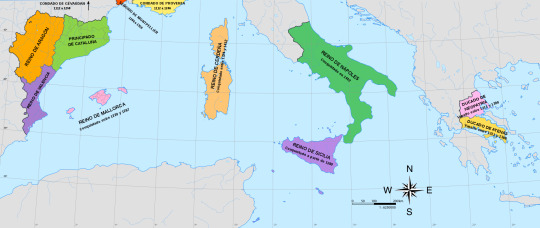
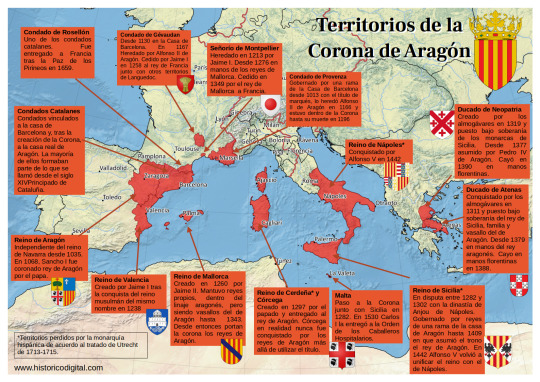
Sibila de Fortiá
Sibila de Fortiá (Fortiá, Girona, Catalonia, 1350 - Barcelona, Catalonia, 1406), queen consort of the Crown of Aragon (1377-1387). She was the daughter of Berenguer de Fortiá and his wife Francesca de Vilamarí. In 1371 she married for the first time Artal de Foces, an Aragonese nobleman, whom she widowed in 1374, and then she the lover of Pedro IV and had a daughter with him, Isabel.Pedro and Sibila married in 1377. After the wedding, Pedro surrounded himself with Empordà nobles as well as Sibila's relatives.
Pedro IV was very ill at the end of the year 1386, and Sibila, fearful of the wrath of the future King Juan, fled to the castle of San Martín de Sarroca (Barcelona), which belonged to her brother Bernat de Fortiá. There she was imprisoned by Juan I, who treated her harshly, accusing her of abandoning the king on his deathbed and of several robberies in the palace. She was confined in the castle of Moncada (Barcelona) until she renounced his property granted by the king. Finally, Sibila retired to the convent of San Francisco in Barcelona, where she died in 1406.
Juan I
Juan I of Aragon, called the Hunter or the Lover of All Kindness (Perpignan, Occitania, France, 1350 - Torroella de Montgrí, Girona, Catalonia, 1396), King of Aragon, Valencia, Mallorca, Sardinia and Corsica, and Count of Barcelona, Roussillon and Cerdanya ( 1387-1396). Son of Pedro IV and Leonor of Sicily.
His first marriage was with Marta de Armagnac (1347-1378), daughter of Count Juan I de Armagnac. With whom he had: Jaime (1374), Juana, (1375-1407) who married Mateo, Count of Foix. After the death of her father, she claimed the throne with her husband, but they were defeated; Juan (1376), Alfonso (1377) and Leonor (1378).
Widowed, Juan married Violante de Bar (1365-1431), daughter of Robert I, Duke of Bar. Offspring:
Jaime Duke of Girona (1382-1388), Yolanda, who married Louis II of Anjou, titular king of Naples. Their son, Luis III, claimed the throne after the death of Martín I, in the engagement of Caspe; Fernando Duke of Girona (1389), Antonia (1391-1392), Juan Duke of Girona (1392-1396), Eleanor (1393), Pedro Duke of Girona (1394) and Juan (1396)
Martin I
Martin I of Aragon, also called the Human or the Old (Girona, July 29, 1356-Barcelona, May 31, 1410), was king of Aragon, of Valencia, of Majorca, of Sardinia and count of Barcelona (1396-1420) and king of Sicily (1409-1410). Second son of Pedro IV of Aragon and his third wife Leonor of Sicily.
Martín was called "the Human" because of his great passion for the Humanities and books. The library of Martín I is the first that could be considered from Renaissance, if at that time in the history of the Iberian peninsula the term can already be used.
Martin married in 1372 with Maria de Luna, daughter of Lope, the first count of Luna, in 1374. From this union they were born:
Jaime (1378), Juan (1380) and Margarita (1388) and Martin I of Sicily "the Younger" (1376-1409), first husband of Blanca I of Navarra.
When Martin the Younger died, Martin married Margarita de Frades, although they left no issue.
His entire reign was marked by the Western Schism that divided Christianity since 1378. He was a supporter of the popes of Avignon (where he went the year of his coronation to swear allegiance to Benedict XIII "the Pope Luna", Pedro Martínez de Luna y Pérez de Gotor, with whom it seems that he came to establish a friendly relationship ), from whom he obtained support in his claims over the kingdom of Sicily against the Anjou, supporters of the popes of Rome. In 1400, he would marry his niece Yolanda to Louis II of Anjou in order to defuse tensions. He met in Avignon with the antipope Benedict XIII, Aragonese and a relative of the queen, with the intention of reaching a solution to the schism and, later, in 1403 he intervened militarily against the siege that Benedict suffered in his papal seat, rescuing him and welcoming him in Peñíscola .
House of Trastamara (the Aragonese branch)
Fernando I
Ferdinand I of Aragon (Medina del Campo, Valladolid, Castile and Leon, November 27, 1380-Igualada, April 2, 1416), also called Fernando de Trastámara and Fernando de Antequera, the Just and the Honest, was an infant of Castile, king of Aragon, Valencia, Mallorca, Sardinia, Count of Barcelona (1412-1416), and regent of Castile (1406-1415), during the minority of Juan II of Castile. Son of Juan I of Castile and Leonor of Aragon.
He was the first Aragonese monarch of the Castilian dynasty of the Trastámara, although he was of Aragonese origin on his mother's side.
He married Leonor de Alburquerque
Alfonso the Magnanimous (Medina del Campo, 1394-1458), king of Aragon, with the name of Alfonso V, and of Naples and Sicily, with the name of Alfonso I.
María de Aragón (Medina del Campo, 1396-1445), first wife of Juan II of Castile and mother of Enrique V of Castile
Juan II (Medina del Campo, 1397-1479), King of Aragon and King consort of Navarre.
Enrique (1400-Calatayud, 1445), II Duke of Villena, III Count of Alburquerque, Count of Ampurias, Grand Master of the Order of Santiago.
Leonor (1402-1445), who married Eduardo I of Portugal. Mother of Alfonso V of Portugal, Juana of Portugal (Enrique IV's second wife) and Leonor of Portugal, who married Frederick III of Habsburg (they were parents of emperor Maximilian I of Austria)
Pedro (1406-1438), IV Count of Alburquerque, Duke of Noto.
Sancho (1400-1416)
Alfonso V
Alfonso V of Aragon (Medina del Campo, 1396 – Naples, June 27, 1458), also called the Wise or the Magnanimous, king of Aragon, of Valencia, of Majorca, of Sicily, of Sardinia and Count of Barcelona (1426-1458); and King of Naples (1446-1458).
Alfonso V can be considered as a genuine prince of the Renaissance, since he developed an important cultural and literary patronage that earned him the nickname of the Wise and that would make Naples the main focus of the entry of Renaissance humanism in the sphere of the Crown of Aragon.
From his relationship with his lover Giraldona de Carlino, a napolitan noblewoman, he had three children:
Fernando (1423-1494), his successor in the kingdom of Naples under the name Fernando I.
Maria (1425-1449), married to Lionel, Marquis of Este and Duke of Ferrara.
Leonor, or Diana Eleonora (?-1450), married the nobleman Marino Marzano, Prince of Rossano.
Maria of Castile
María of Castile (Segovia, Castile and Leon, November 14, 1401-Valencia, October 4, 1458). Infanta of Castile, Princess of Asturias (1402-1405) and Queen of Aragon (1416-1458) for her marriage to Alfonso the Magnanimous. First daughter of Enrique III "the Mourner" and Catherine of Lancaster. Sister of Juan II of Castile, untie of Enrique IV and Isabel I.
The marriage between María and Alfonso is celebrated in the Cathedral of Valencia on October 12, 1415. The ceremony was officiated by the antipope Benedict XIII, who also granted the matrimonial dispensation for the wedding.
In 1420, when the king left for Naples for the first time, he left the government of his kingdoms in the hands of Maria as lieutenant general. The absence of the Magnanimous would last three years, during which María had to face the rapid deterioration of the economic situation in Catalonia, the territorial struggle with the Castilian Crown, as well as the conflicts of a social nature that shook her in different kingdoms. On his return to Aragon in 1423, Alfonso V began the war with Castile, along with his brother King Juan of Navarra. But her financial resources were exhausted and in 1429 Queen María had to act as a mediator between her husband and her brother, King Juan II of Castile, to put an end to the dispute. However, Alfonso's situation did not improve, due to the recession suffered by the Catalan economy and the social conflicts caused by it. The Courts of Barcelona in 1431 demanded from the king a series of measures to correct the enormous deficit of the Catalan treasury and trade. But Alfonso, fed up with these matters, returned to Italy and gave full powers to the queen as ruler of Aragon; he left the Iberian Peninsula forever on May 29, 1432. This marked Alfonso V's final break with the Crown of Aragon, which, however, he never renounced.
+ Bonus track (although he doesn't appear in this series)
Juan II
Juan II of Aragon and Navarra, the Great, or the Faithless according to the Catalan rebels who rose up against him (Medina del Campo, June 29, 1398-Barcelona, January 20, 1479) was Duke of Peñafiel, King of Navarre (1425-1479), King of Sicily (1458-1468) and King of Aragon, Mallorca, Valencia, Sardinia (1458-1479) and Count of Barcelona, son of Ferdinand I of Aragon and Leonor de Albuquerque.
From his first marriage to Blanca I of Navarra (daughter of Leonor of Castile and Carlos III of Navarra):
Carlos (1421-1461), Prince of Viana and Girona, Duke of Gandia and Montblanch, titular King of Navarra as Carlos IV (1441–1461), married Agnes of Cleves. He wrote the 'Chronicles of the Monarchs of Navarra', about the history of his antecessors, from Eneko Arizta in the 8th century up to the 15th century.
Juan (1423-1425)
Blanca of Navarra (1424-1464), first wife of Enrique IV of Castile
Leonor (1425-1479), married to Gastón IV de Foix, Queen of Navarre under the name of Leonor I.
From his second marriage to Juana Enríquez:
Leonor of Aragon (1448)
Fernando II (1452-1516), king iure uxoris of Castile (1474-1504) and then regent between 1507 and 1516, under the name of Fernando V due to his marriage to Isabel I, king of Sicily (as Fernando II, 1468-1516), Aragon and Sardinia (as Fernando II, 1479-1516), Naples (as Fernando III, 1504-1516), and from Navarra (as Fernando I, 1512-1516)
Juana (1455-1517), second wife of Fernando I of Naples. Her daughter Juana married Fernando II of Naples (Fernando I of Naples' grandson)
During his youth, Juan fought in the Castilian-Aragonese war (1429-30) and the Castilian Civil War (1437-1445) in the Aragonese team against Juan II of Castile, his son Enrique and the Constable Álvaro de Luna (favourite of Juan II), due to the Aragonese political influences in Castile and the full control that Álvaro de Luna had over Juan II of Castile that allowed him to become very powerful, so some members of the Castilian nobility wanted to remove Álvaro out of Juan II side because of that, and the Aragonese reacted to the anti-aragonese convictons of Álvaro.
Álvaro de Luna arranged a new marriage between Juan II of Castile and Isabel of Portugal (mother of Isabel I) in 1447. The constable intended with this dynastic alliance to strengthen the political ties that united Castile and Portugal against the common enemy: the Catalan-Aragonese Crown, but from 1449, Isabella of Portugal indirectly supported the maneuvers of the Great League of Nobles (allies of the Aragonese) formed against the constable. But it would not be until 1453 when Juan II of Castile, possibly tired of the continuous pressure from the aristocracy, left Álvaro on his own. It has often been said that it was the queen herself who demanded that her husband signed the prison order against Álvaro, through Juan Pacheco, Marquis of Villena.
By 1441 Blanca I de Navarra died and Juan II married the daughter of Fadrique Enríquez (one of his Castilian allies, the admiral of Castile), Juana Enríquez y Fernández de Córdoba.
After the death of Blanca I, a dispute between Juan II and Carlos de Viana about the sucession for the Navarrese throne. Juan was king Iure uxoris of Navarre and wanted to be keep his position as king, but Carlos and his supporters claimed that the prince was the rightful king as firstborn son of the queen and in 1451 the Navarrese civil war started.
In the following years the tension between Juan and Carlos increased with the birth of Fernando, who was pushed by his mother Juana to be the heir of Aragon and Navarra, which Juan later accepted. This change in the sucession was not accepted in Catalonia, that supported Carlos de Viana birthrights, and they started a rebellion against Juan II.
Other supporter of Carlos was Enrique IV, who offered his sister Isabel to Carlos in marriage as a sign of their alliance, but the wedding never happened.
Carlos died in 1461, although the war didn't ended because the Catalan nobility proposed other suitors for the Crown of Aragon and the Principality of Catalonia, like Enrique IV, Pedro of Portugal (grandson of Jaime II of Urgell) and Renato de Anjou during the Catalan civil war, that ended in 1472.
It's interesting that the interesting that the current situation of the Estanyol family at the end of Los Herederos de la tierra is that there are two brothers from different mothers, and whose father have benefited one of them over the other, so it may lead to tensions from the part that was not benefited, Arnau Jr is the main heir in Bernat's will, so maybe in the future Marta Destorrent will try to pit her son Baltasar against his elder brother to take Arnau Jr's place. By period of time I find very likely that this happens during the reigns Maria of Castile and Juan II, and the situation of the Estanyol succession could parallel the Carlos de Viana-Fernando II problem, although in this case the younger son was the benefited one and the one who inherited his father's kingdoms and maybe the Estanyols are part of the Catalan nobility that defended Carlos' birthrights, although some other Catalan nobles supported Juan II & Fernando alongside of peasants and smallfolk, during the First Remensa War during the Catalan civil war.
The Remensa War consisted in revolts organised by peasants who wanted to end the servitude to which their feudal lords had subjected them, so I think that probably the Estanyol-Llor family would support the peasants because of their backgrounds.
#la catedral del mar#los herederos de la tierra#the cathedral of the sea#heirs to the land#history#crown of aragon#aragonese monarchs#pedro iv de aragón#juan i de aragón#martín i de aragón#sibila de fortiá#fernando i de aragón#alfonso v de aragón#maria de castilla#juan ii de aragón#gifs#period dramas#house of aragon#house of trastamara#house of barcelona#long post
21 notes
·
View notes
Photo



Marble bust of Ferdinand II of Aragon, circa 1468
Author: attributed to Giovanni Cristoforo Romano (before 1470)/Francesco Laurana (?)
Place of origin stylistically: Palermo
Material: marble with the last of paint
Height: 46 cm
Width: 30 cm
Depth: 21 cm
Weight: 19 kg
Sculpture Collection and Museum of Byzantine Art of the National Museums in Berlin - Preußischer Kulturbesitz
#art#bust#sculpture#ferdinand ii of aragon#fernando ii de aragón#giovanni cristoforo romano#francesco laurana#staatlichemuseenzuberlin
38 notes
·
View notes
Photo




“The most conclusive testimony to the success of Henry's administration consists perhaps in the feebleness of the indictment which Perkin Warbeck brought when he made his second invasion from Scotland.
The obscurity of his Tudor descent is cast in Henry's teeth; his “caitiff and villain” councillors; the proscription of Warbeck's adherents; Warwick's imprisonment and disinheritance; “the great and execrable offences daily committed and done by our foresaid great enemy and his adherents in breaking the liberties and franchises of our Mother Holy Church, to the high displeasure of Almighty God”; the “daily pilling of the people by dismes, taskes, tallages, benevolences, and other unlawful impositions and grievous exactions”; and so forth.
The comparative success of Simnel's imposture, which is not seriously doubted, destroys the theory that there must necessarily have been a substratum of truth in Perkin's pretensions. Nevertheless, Henry's poet laureate, Bernard Andre, gives colour to the suspicion that Perkin was not merely the son of a boatman of Tournay, by recording the story that he was godson to Edward IV; and Bacon embellished the tale.
Another, still more curious, was revealed by the publication in 1913 of the first volume of the Calendar of Milanese State Papers. In February, 1495, Maximilian, King of the Romans, told the Milanese envoy at his court that Sir Robert Clifford had communicated to Henry VII the fact that Perkin was not the son of Edward IV, as he claimed to be, but the son of Edward IV's sister, Margaret of Burgundy, and of the Bishop of Cambray.
It is a story similar to those told about Queen Elizabeth, in which no serious historian places any credence. But Maximilian's object in repeating this scandal about his wife's step-mother is difficult to understand, more especially as he was still himself an active supporter of Perkin's pretensions.
In 1498 the bishop was in England on an embassy from the Netherlands, and specially desired to see Perkin, as, Puebla tells us, “he had formerly transacted business with him.” Henry thereupon summoned Perkin from the Tower and questioned him in Puebla's and apparently in the Bishop's presence.
If there was any truth in the story, this confrontation must have afforded Henry some grim amusement, which would not be lessened by Perkin's answer, as reported by Puebla, to the effect that Margaret of Burgundy knew as well as he did that he was not the son of Edward IV.
[...] The year of Perkin's capture, which was the central year of Henry's reign, was also its annus mirabilis. The Scottish invasion had been repulsed; Warbeck's attempts on Ireland had been frustrated by Waterford's loyalty; the second rebellion of the turbulent commons of Cornwall had ended in smoke; and Cabot had discovered Newfoundland.
Foreign princes began to respect Henry's accomplished facts, and their envoys in England impressed upon them the strength of his position.
“I repeat”,the Milanese envoy informs his master, Ludovic Sforza, “that this present state is most stable, even for the king's descendants, since there is no one who aspires to the Crown; with concord at home they have no occasion to fear”; and again, “from this time forward he is perfectly secure against Fortune”
“Henry is rich," wrote two Spanish envoys from London in July, 1498, “has established good order in England, and keeps the people in such subjection as has never been the case before.”
“His Majesty can stand” reiterates Soncino, “like one at the top of a tower looking on at what is passing in the plain.”
“England”, averred Puebla early in 1500, “has never been so tranquil and obedient as at present”
More material rewards were reaped than this chorus of appreciation. Ferdinand and Isabella finally made up their minds that Arthur would be a suitable match for their daughter Catherine, and contributed to the prospects of the pair by smoothing the way, through Ayala's agency, for peace between England and Scotland.
Louis XII of France hastened to surrender John Taylor who had planned Warbeck's first Irish adventure, and further strengthened Henry's position by reviving the Orleanist claims to Naples and thus involving France in a perennial contest with Spain for Italian supremacy.”
Source: “The Reign of Henry VII From Contemporary Sources.”Selected and Arranged With An Introduction By A.F. Poland. Volume I. 1913.
#King Henry VII#Henry VII#Perkin Warbeck#richard plantagenet#Prince in the Tower#Duke of York#Pretender#Tudor dynasty#Henry Tudor#The Tudors#Tudors#Tudor#House of Tudor#Isabel de Castela#Isabella of Castille#Reina Isabel#Ferdinand of Aragon#Fernando de Aragón#Rey Fernando II#Prince Arthur#Arthur Tudor#Prince of Wales#Catherine of Aragon#Infanta Catarina#Ludovico Sforza#Diplomacy#International relations#politics#regal power#monarchy
130 notes
·
View notes